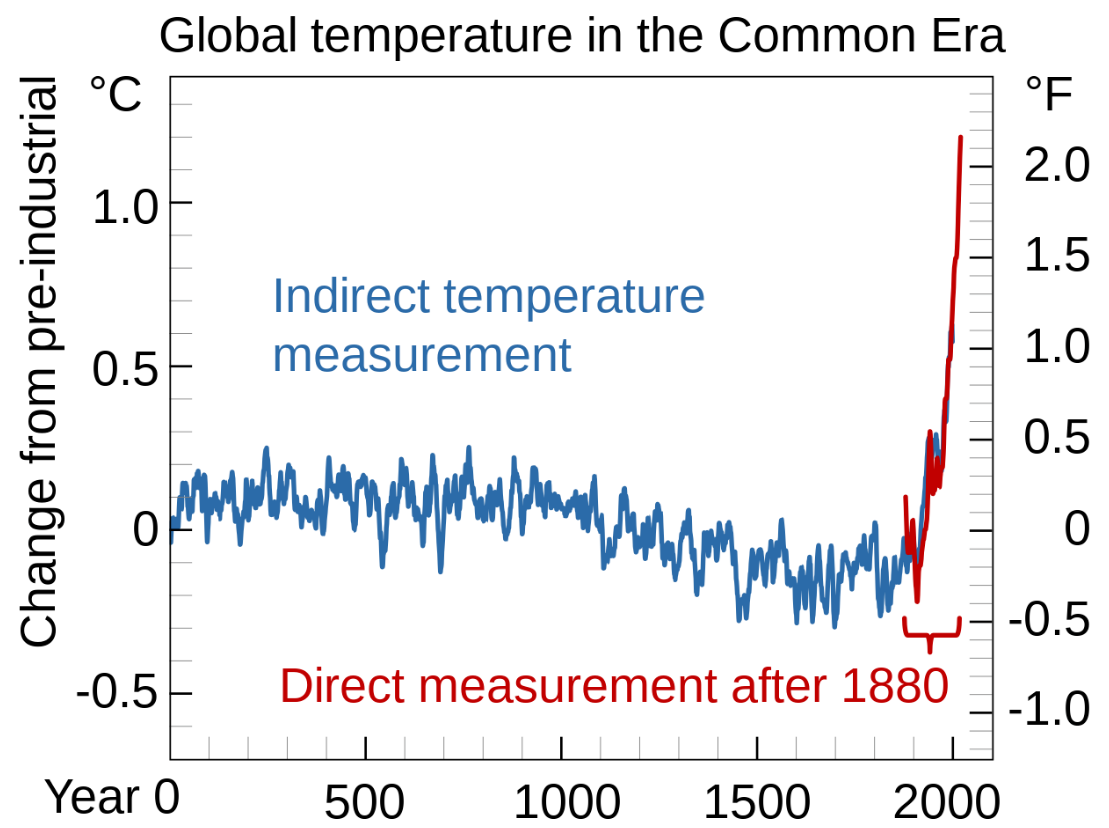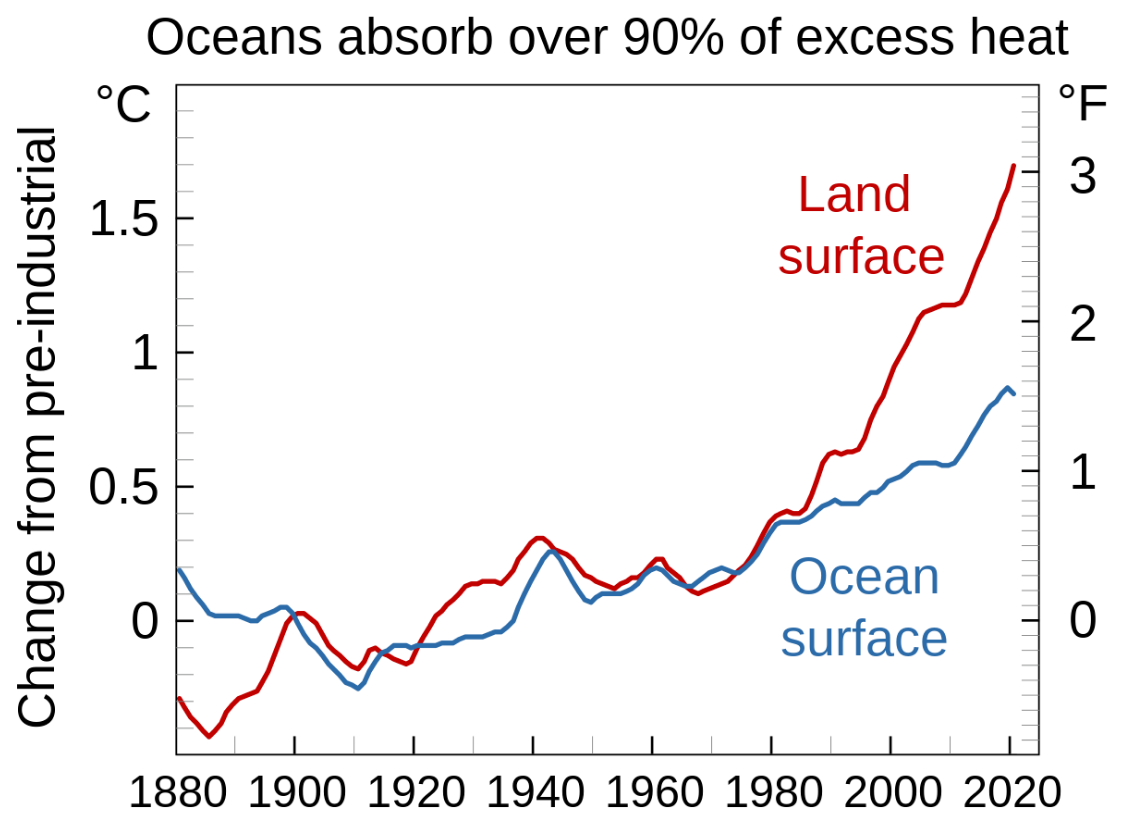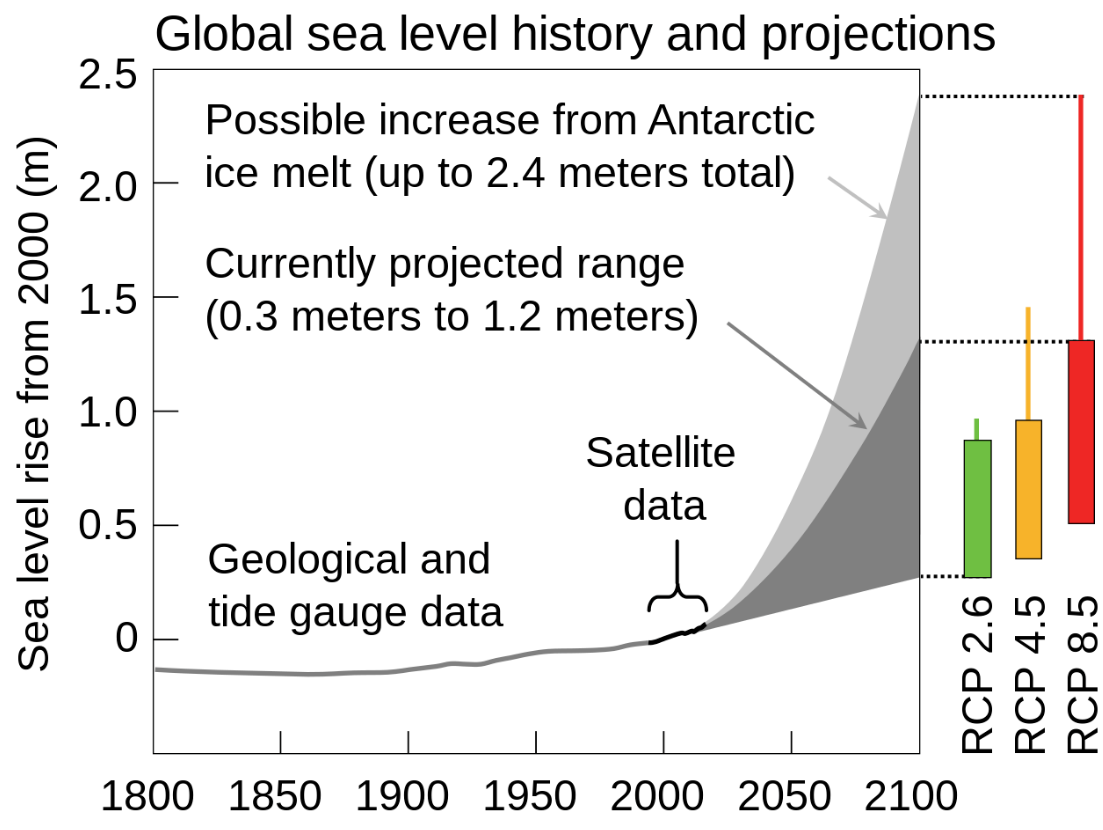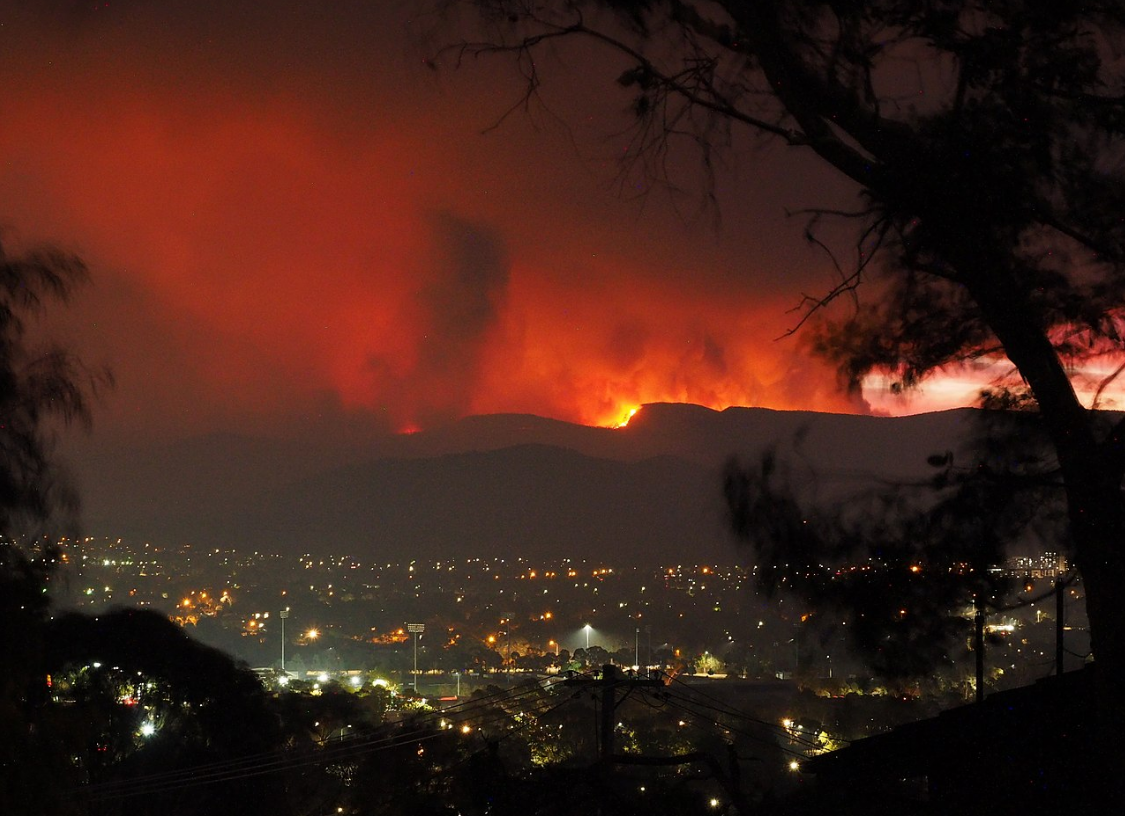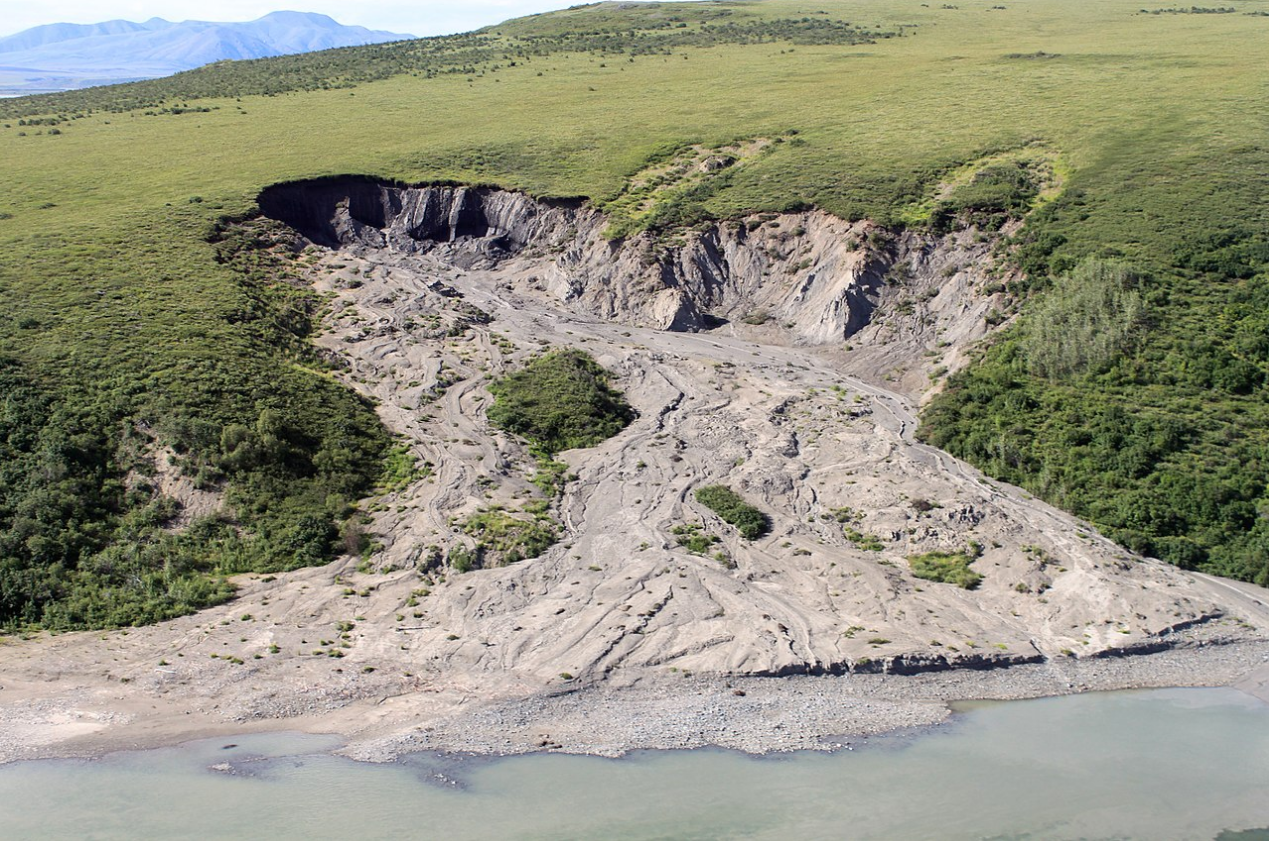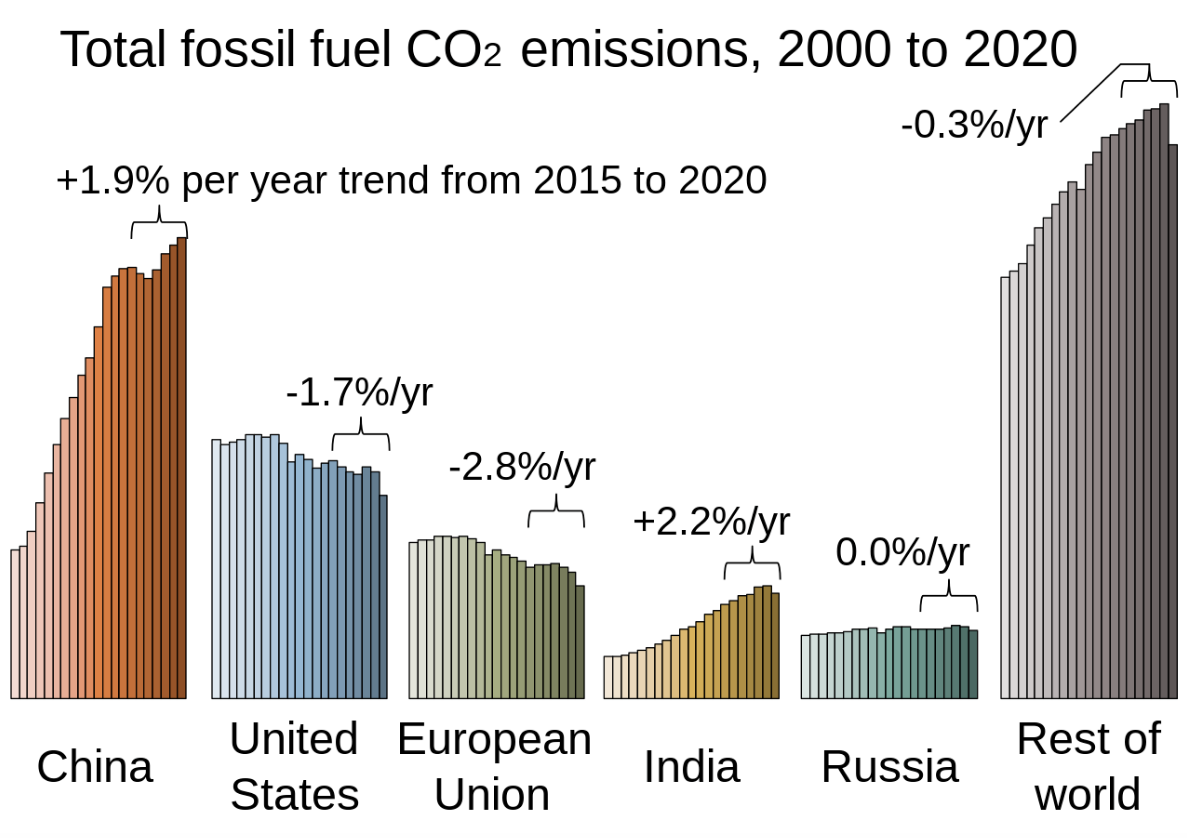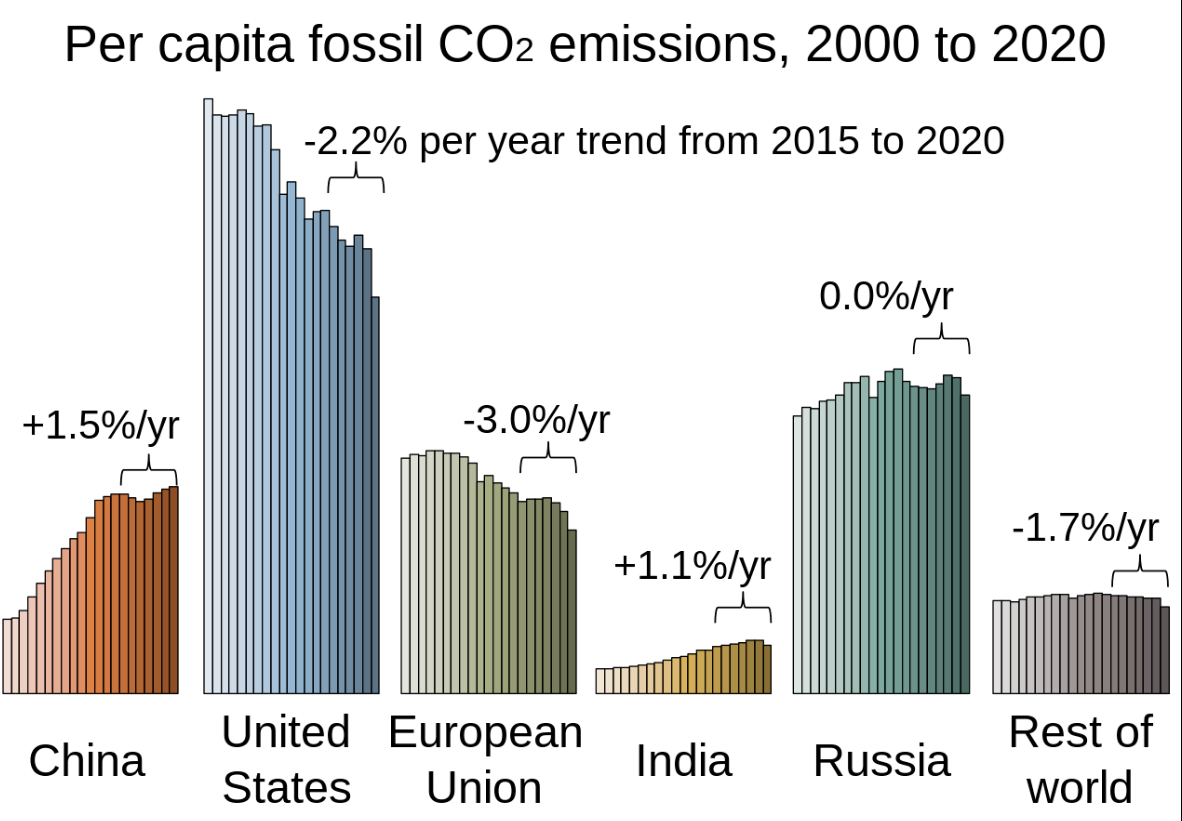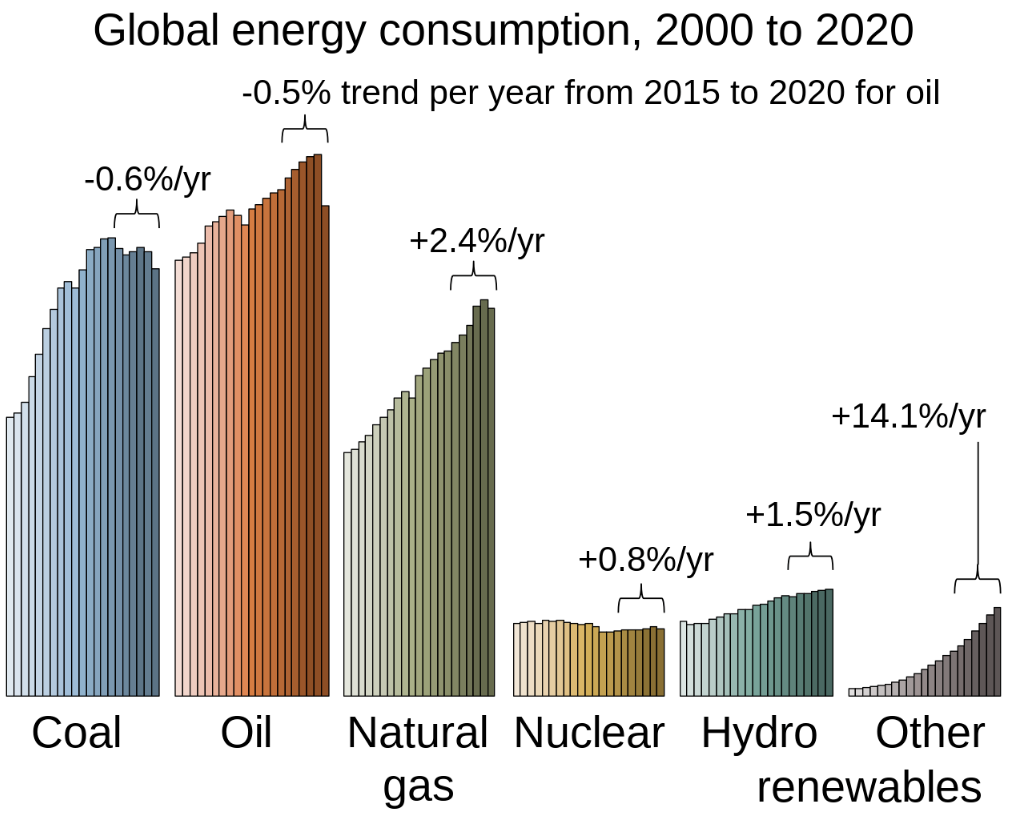Global warming is the ongoing rise of the average temperature of the Earth's climate system. It is a major aspect of climate change which, in addition to rising global surface temperatures, also includes its effects, such as changes in precipitation. While there have been prehistoric periods of global warming, observed changes since the mid-20th century have been unprecedented in rate and scale. The Intergovernmental Panel on Climate Change (IPCC) concluded that "human influence on climate has been the dominant cause of observed warming since the mid-20th century". These findings have been recognized by the national science academies of major nations and are not disputed by any scientific body of national or international standing. The largest human influence has been the emission of greenhouse gases, with over 90% of the impact from carbon dioxide and methane. Fossil fuel burning is the principal source of these gases, with agricultural emissions and deforestation also playing significant roles. Climate sensitivity to these gases is affected by feedbacks, such as loss of snow cover, increased water vapour, and melting permafrost. Land surfaces are heating faster than the ocean surface, leading to heat waves, wildfires, and the expansion of deserts. Increasing atmospheric energy and rates of evaporation are causing more intense storms and weather extremes, damaging infrastructure and agriculture. Surface temperature increases are greatest in the Arctic and have contributed to the retreat of glaciers, permafrost, and sea ice. Environmental impacts include the extinction or relocation of many species as their ecosystems change, most immediately in coral reefs, mountains, and the Arctic. Surface temperatures would stabilize and decline a little if emissions were cut off, but other impacts will continue for centuries, including rising sea levels from melting ice sheets, rising ocean temperatures, and ocean acidification from elevated levels of carbon dioxide. Mitigation efforts to address global warming include the development and deployment of low carbon energy technologies, policies to reduce fossil fuel emissions, reforestation, forest preservation, as well as the development of potential climate engineering technologies. Societies and governments are also working to adapt to current and future global warming impacts, including improved coastline protection, better disaster management, and the development of more resistant crops. Countries work together on climate change under the umbrella of the United Nations Framework Convention on Climate Change (UNFCCC), which has near-universal membership. The goal of the convention is to "prevent dangerous anthropogenic interference with the climate system". The IPCC has stressed the need to keep global warming below 1.5 °C (2.7 °F) compared to pre-industrial levels in order to avoid some irreversible impacts. With current policies and pledges, global warming by the end of the century is expected to reach about 2.8 °C (5.0 °F). At the current greenhouse gas (GHG) emission rate, the carbon budget for staying below 1.5 °C (2.7 °F) would be exhausted by 2028.
- climate engineering
- low carbon energy
- global warming
1. Observed Temperature Rise
Multiple independently produced instrumental datasets confirm that the 2009–2018 decade was 0.93 ± 0.07 °C (1.67 ± 0.13 °F) warmer than the pre-industrial baseline (1850–1900).[3][17] Currently, surface temperatures are rising by about 0.2 °C (0.36 °F) per decade.[4][18] Since 1950, the number of cold days and nights has decreased, and the number of warm days and nights has increased.[5][19] Historical patterns of warming and cooling, like the Medieval Climate Anomaly and the Little Ice Age, were not as synchronous as current warming, but may have reached temperatures as high as those of the late-20th century in a limited set of regions.[6][20] There have been prehistorical episodes of global warming, such as the Paleocene–Eocene Thermal Maximum.[7][21] However, the observed rise in temperature and CO
2 concentrations has been so rapid that even abrupt geophysical events that took place in Earth's history do not approach current rates.[8][22]
Climate proxy records show that natural variations offset the early effects of the Industrial Revolution, so there was little net warming between the 18th century and the mid-19th century,[9][23] when thermometer records began to provide global coverage.[10][24] The Intergovernmental Panel on Climate Change (IPCC) has adopted the baseline reference period 1850–1900 as an approximation of pre-industrial global mean surface temperature.[9][23]
The warming evident in the instrumental temperature record is consistent with a wide range of observations, documented by many independent scientific groups.[11][25] Although the most common measure of global warming is the increase in the near-surface atmospheric temperature, over 90% of the additional energy in the climate system over the last 50 years has been stored in the ocean, warming it.[12][26] The remainder of the additional energy has melted ice and warmed the continents and the atmosphere.[13][27] The ocean heat uptake drives thermal expansion which has contributed to observed sea level rise.[14][28] Further indicators of climate change include an increase in the frequency and intensity of heavy precipitation, melting of snow and land ice and increased atmospheric humidity.[15][29] Flora and fauna also portray behaviour consistent with warming, such as the earlier flowering of plants in spring.[16][30]
1.1. Regional Trends
Global warming refers to global averages, with the amount of warming varying by region. Since the pre-industrial period, global average land temperatures have increased almost twice as fast as global average temperatures.[17][31] This is due to the larger heat capacity of oceans and because oceans lose more heat by evaporation.[18][32] Patterns of warming are independent of the locations of greenhouse gas emissions because the gases persist long enough to diffuse across the planet; however, localized black carbon deposits on snow and ice do contribute to Arctic warming.[19][33]
The Northern Hemisphere and North Pole have warmed much faster than the South Pole and Southern Hemisphere. The Northern Hemisphere not only has much more land, but also more snow area and sea ice, because of how the land masses are arranged around the Arctic Ocean. As these surfaces flip from being reflective to dark after the ice has melted, they start absorbing more heat. The Southern Hemisphere already had little sea ice in summer before it started warming.[20][34] Arctic temperatures have increased and are predicted to continue to increase during this century at over twice the rate of the rest of the world.[21][35] As the temperature difference between the Arctic and the equator decreases, ocean currents that are driven by that temperature difference, like the Gulf Stream, weaken.[22][36]
1.2. Warmer and Colder Years
Although record-breaking years attract considerable media attention, individual years are less significant than the overall global surface temperature, which is subject to short-term fluctuations that overlie long-term trends.[23][37] An example of such an episode is the slower rate of surface temperature increase from 1998 to 2012, which was described as the global warming hiatus.[24][38] Throughout this period, ocean heat storage continued to progress steadily upwards, and in subsequent years, surface temperatures have spiked upwards. The slower pace of warming can be attributed to a combination of natural fluctuations, reduced solar activity, and increased reflection sunlight of by particles from volcanic eruptions.[25][39]
2. Physical Drivers of Recent Climate Change
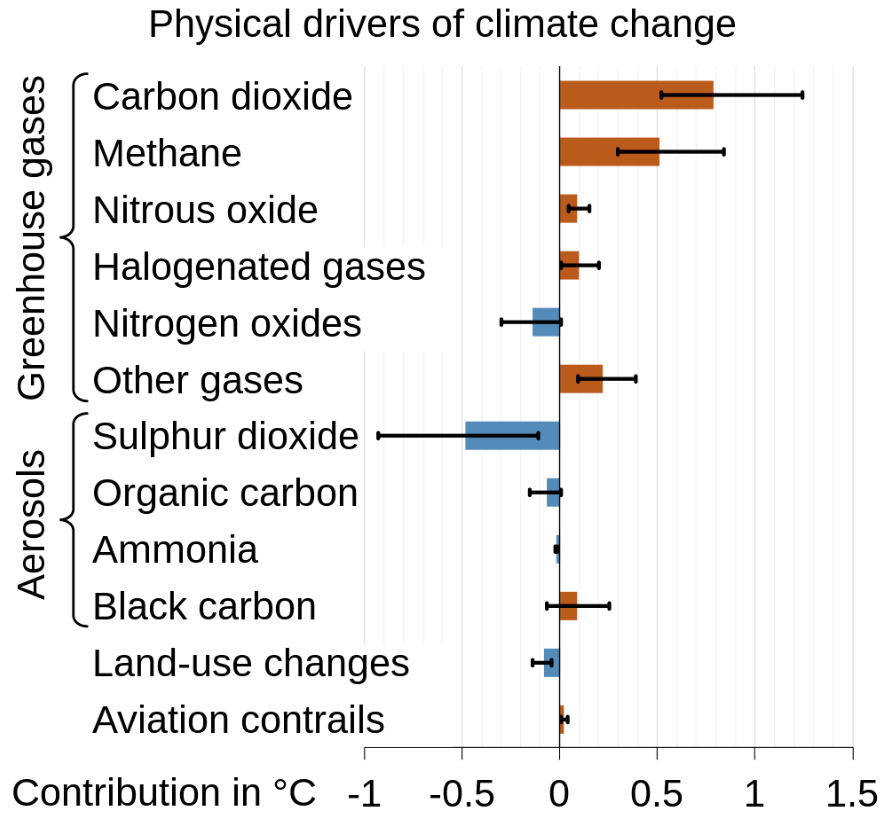
By itself, the climate system experiences various cycles which can last for years (such as the El Niño–Southern Oscillation) to decades or centuries.[26][40] Other changes are caused by an imbalance of energy at the top of the atmosphere: external forcings. These forcings are "external" to the climate system, but not always external to the Earth.[27][41] Examples of external forcings include changes in the composition of the atmosphere (e.g. increased concentrations of greenhouse gases), solar luminosity, volcanic eruptions, and variations in the Earth's orbit around the Sun.[28][42]
Attribution of climate change is the effort to scientifically show which mechanisms are responsible for observed changes in Earth's climate. First, known internal climate variability and natural external forcings need to be ruled out. Therefore, a key approach is to use computer modelling of the climate system to determine unique "fingerprints" for all potential causes. By comparing these fingerprints with observed patterns and evolution of climate change, and the observed history of the forcings, the causes of the observed changes can be determined.[29][43] For example, solar forcing can be ruled out as major cause because its fingerprint is warming in the entire atmosphere, and only the lower atmosphere has warmed as expected for greenhouse gases.[30][44] The major causes of current climate change are primarily greenhouse gases, and secondarily land use changes, and aerosols and soot.[31][45]
2.1. Greenhouse Gases
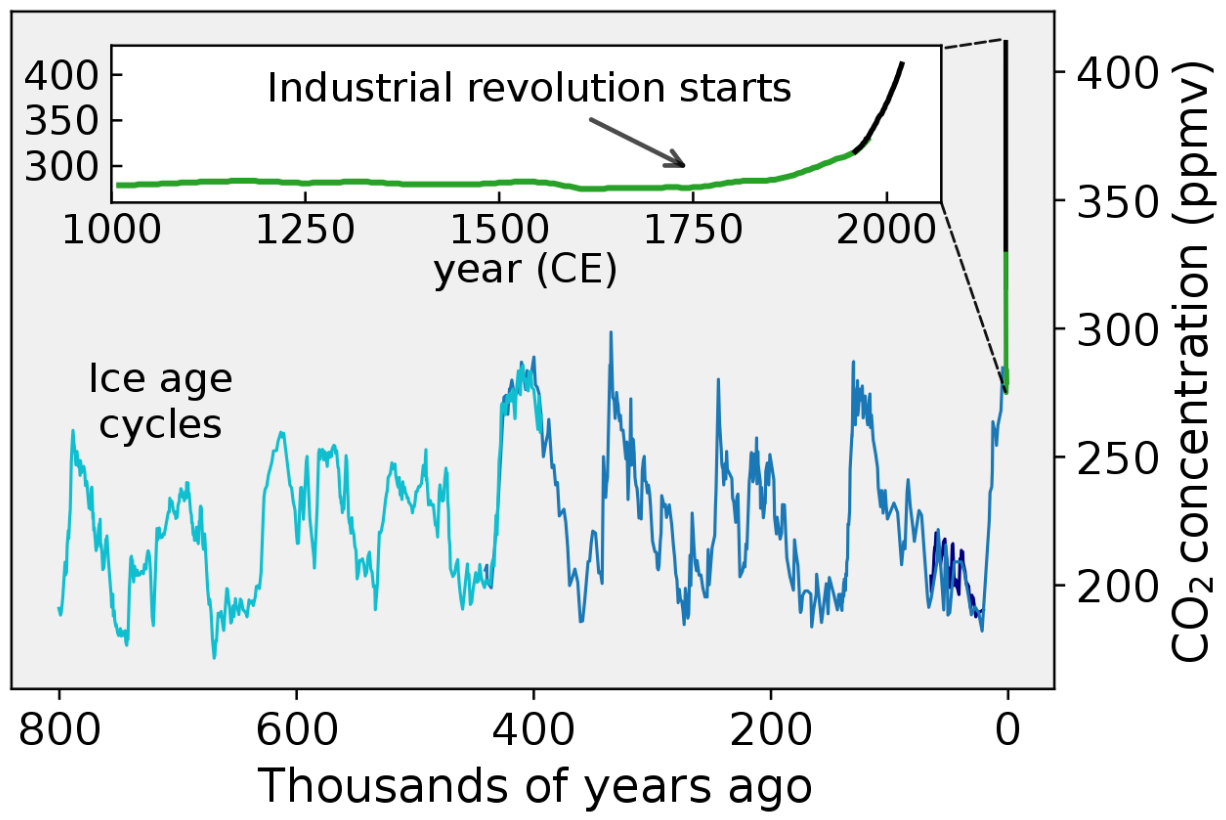
Greenhouse gases trap heat radiating from the Earth to space.[32][46] This heat, in the form of infrared radiation, gets absorbed and emitted by these gases in the atmosphere, thus warming the lower atmosphere and the surface. Before the Industrial Revolution, naturally occurring amounts of greenhouse gases caused the air near the surface to be warmer by about 33 °C (59 °F) than it would be in their absence.[33][47] Without the Earth's atmosphere, the Earth's average temperature would be well below the freezing temperature of water.[34][48] While water vapour (~50%) and clouds (~25%) are the biggest contributors to the greenhouse effect, they increase as a function of temperature and are therefore considered feedbacks. Increased concentrations of gases such as CO
2 (~20%), ozone and N
2O are external forcing on the other hand.[35][49] Ozone acts as a greenhouse gas in the lowest layer of the atmosphere, the troposphere. Furthermore, it is highly reactive and interacts with other greenhouse gases and aerosols.[36][50]
Human activity since the Industrial Revolution, mainly extracting and burning fossil fuels,[37][51] has increased the amount of greenhouse gases in the atmosphere. This CO2, methane, tropospheric ozone, CFCs, and nitrous oxide has increased radiative forcing. In 2018, the concentrations of CO2 and methane had increased by about 45% and 160%, respectively, since pre-industrial times.[38][52] In 2013, CO2 readings taken at the world's primary benchmark site in Mauna Loa surpassing 400 ppm for the first time.[39][53] These levels are much higher than at any time during the last 800,000 years, the period for which reliable data have been collected from ice cores.[40][54] Less direct geological evidence indicates that CO2 values have not been this high for millions of years.[41][55]

Global anthropogenic greenhouse gas emissions in 2018 excluding land use change were equivalent to 52 billion tonnes of carbon dioxide. Of these emissions, 72% was carbon dioxide from fossil fuel burning and industry, 19% was methane, largely from livestock,[42][56] 6% was nitrous oxide, mainly from agriculture, and 3% was fluorinated gases.[43][57] A further 4 billion tonnes of CO
2 was released as a consequence of land use change, which is primarily due to deforestation.[44][58] From a production standpoint, the primary sources of global GHG emissions are estimated as: electricity and heat (25%), agriculture and forestry (24%), industry (21%), and transportation (14%).[45][59] Consumption based estimates of GHG emissions offer another useful way to understand sources of global warming, and may better capture the effects of trade.[46][60] From a consumption standpoint, the dominant sources of global 2010 emissions were found to be: food (30%), washing, heating, and lighting (26%); personal transport and freight (20%); and building construction (15%).[47][61]
Despite the contribution of deforestation to GHG emissions, the Earth's land surface, particularly its forests, remain a significant carbon sink for CO
2. Natural processes, such as carbon fixation in the soil and photosynthesis, more than offset the GHG contributions from deforestation. The land surface sink is estimated to remove about 11 billion tonnes of CO
2 annually from the atmosphere, or about 29% of global CO
2 emissions.[48][62] The ocean also serves as a significant carbon sink via a two-step process. First, CO
2 dissolves in the surface water. Afterwards, the ocean's overturning circulation distributes it deep into the ocean's interior, where it accumulates over time as part of the carbon cycle. Over the last two decades, the world's oceans have removed between 20 and 30% of emitted CO
2.[49][63] The strength of both the land and ocean sinks increase as CO
2 levels in the atmosphere rise. In this respect they act as negative feedbacks in global warming.[50][64]
2.2. Land Surface Change
Humans change the Earth's surface mainly to create more agricultural land. Today agriculture takes up 50% of the world's habitable land, while 37% is forests,[51][65] and that latter figure continues to decrease,[52][66] largely due to continued forest loss in the tropics.[53][67] This deforestation is the most significant aspect of land use change affecting global warming. The main causes are: deforestation through permanent land use change for agricultural products such as beef and palm oil (27%), forestry/forest products (26%), short term agricultural cultivation (24%), and wildfires (23%).[54][68]
In addition to impacting greenhouse gas concentrations, land use changes affect global warming through a variety of other chemical and physical dynamics. Changing the type of vegetation in a region impacts the local temperature by changing how much sunlight gets reflected back into space, called albedo, and how much heat is lost by evaporation. For instance, the change from a dark forest to grassland makes the surface lighter, causing it to reflect more sunlight. Deforestation can also contribute to changing temperatures by affecting the release of aerosols and other chemical compounds that affect clouds; and by changing wind patterns when the land surface has different obstacles.[55][69] Globally, these effects are estimated to have led to a slight cooling, dominated by an increase in surface albedo.[56][70] But there is significant geographic variation in how this works. In the tropics the net effect is to produce a significant warming, while at latitudes closer to the poles a loss of albedo leads to an overall cooling effect.[55][69]
2.3. Aerosols and Clouds
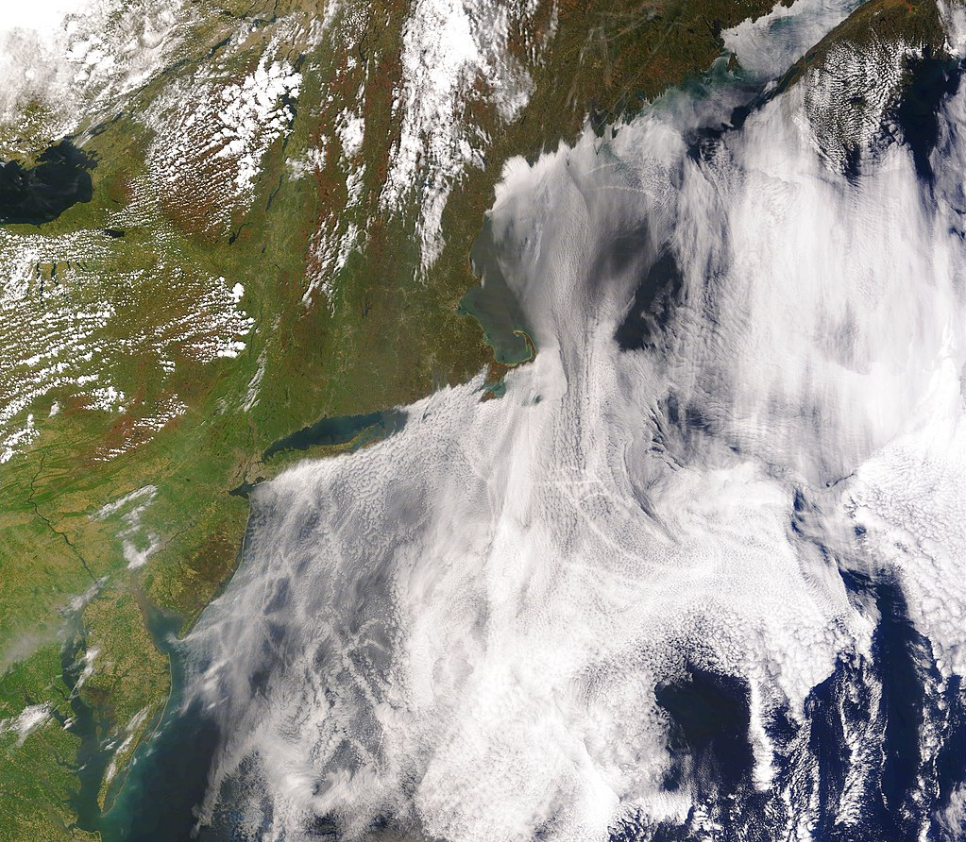
Air pollution, in the form of aerosols, not only puts a large burden on human health, but also affects the climate on a large scale.[57][71] From 1961 to 1990, a gradual reduction in the amount of sunlight reaching the Earth's surface was observed, a phenomenon popularly known as global dimming,[58][72] typically attributed to aerosols from biofuel and fossil fuel burning.[59][73] Aerosol removal by precipitation gives tropospheric aerosols an atmospheric lifetime of only about a week, while stratospheric aerosols can remain in the atmosphere for a few years.[60][74] Globally, aerosols have been declining since 1990, removing some of the masking of global warming that they had been providing.[61][75]
In addition to their direct effect by scattering and absorbing solar radiation, aerosols have indirect effects on the Earth's radiation budget. Sulfate aerosols act as cloud condensation nuclei and thus lead to clouds that have more and smaller cloud droplets. These clouds reflect solar radiation more efficiently than clouds with fewer and larger droplets.[62][76] This effect also causes droplets to be of more uniform size, which reduces the growth of raindrops and makes clouds more reflective to incoming sunlight.[63][77] Indirect effects of aerosols are the largest uncertainty in radiative forcing.[64][78]
While aerosols typically limit global warming by reflecting sunlight, black carbon in soot that falls on snow or ice can contribute to global warming. Not only does this increase the absorption of sunlight, it also increases melting and sea level rise.[65][79] Limiting new black carbon deposits in the Arctic could reduce global warming by 0.2 °C by 2050.[66][80]
2.4. Natural Forcings
As the Sun is the Earth's primary energy source, changes in incoming sunlight directly affect the climate system.[67][81] Solar irradiance has been measured directly by satellites,[68][82] and indirect measurements are available beginning in the early 1600s.[67][81] There has been no upward trend in the amount of the Sun's energy reaching the Earth, so it cannot be responsible for the current warming.[69][83] Physical climate models are also unable to reproduce the rapid warming observed in recent decades when taking into account only variations in solar output and volcanic activity.[70][84] Another line of evidence for the warming not being due to the Sun is how temperature changes differ at different levels in the Earth's atmosphere.[71][85] According to basic physical principles, the greenhouse effect produces warming of the lower atmosphere (the troposphere), but cooling of the upper atmosphere (the stratosphere).[72][86] If solar variations were responsible for the observed warming, warming of both the troposphere and the stratosphere would be expected, but that has not been the case.[30][44] Explosive volcanic eruptions represent the largest natural forcing over the industrial era. When the eruption is sufficiently strong with sulfur dioxide reaching the stratosphere, sunlight can be partially blocked for a couple of years, with a temperature signal lasting about twice as long.[73][87]
3. Climate Change Feedback
-
Sea ice reflects 50 to 70 percent of incoming solar radiation while the dark ocean surface only reflects 6 percent, so melting sea ice is a positive feedback[74][88]. By Christopher Michel - https://www.flickr.com/photos/cmichel67/19626661335/, CC BY 2.0, https://commons.wikimedia.org/w/index.php?curid=41618273
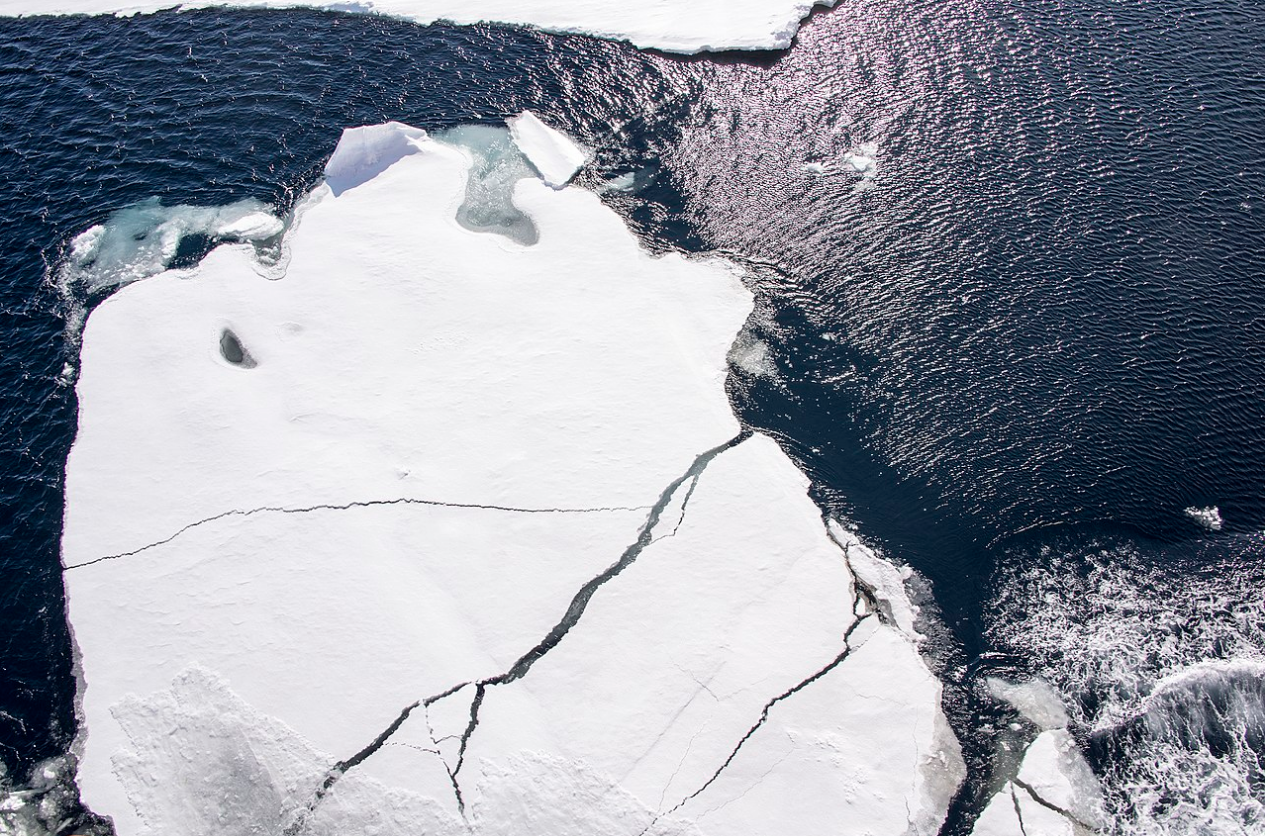
The response of the climate system to an initial forcing is increased by self-reinforcing feedbacks and reduced by balancing feedbacks.[75][89] The main balancing feedback to global temperature change is radiative cooling to space as infrared radiation, which increases strongly with increasing temperature.[76][90] The main reinforcing feedbacks are the water vapour feedback, the ice–albedo feedback, and probably the net effect of clouds.[77][91] Uncertainty over feedbacks is the major reason why different climate models project different magnitudes of warming for a given amount of emissions.[78][92]
As air gets warmer, it can hold more moisture. After an initial warming due to emissions of greenhouse gases, the atmosphere will hold more water. As water is a potent greenhouse gas, this further heats the climate: the water vapour feedback.[77][91] The reduction of snow cover and sea ice in the Arctic reduces the albedo of the Earth's surface.[79][93] More of the Sun's energy is now absorbed in these regions, contributing to Arctic amplification, which has caused Arctic temperatures to increase at more than twice the rate of the rest of the world.[80][94] Arctic amplification also causes methane to be released as permafrost melts, which is expected to surpass land use changes as the second strongest anthropogenic source of greenhouse gases by the end of the century.[81][95]
Cloud cover may change in the future. If cloud cover increases, more sunlight will be reflected back into space, cooling the planet. Simultaneously, the clouds enhance the greenhouse effect, warming the planet. The opposite is true if cloud cover decreases. It depends on the cloud type and location which process is more important. Overall, the net feedback over the industrial era has probably been self-reinforcing.[82][96]
Roughly half of each year's CO2 emissions have been absorbed by plants on land and in oceans.[83][97] Carbon dioxide and an extended growing season have stimulated plant growth making the land carbon cycle a balancing feedback. Climate change also increases droughts and heat waves that inhibit plant growth, which makes it uncertain whether this balancing feedback will persist in the future.[84][98] Soils contain large quantities of carbon and may release some when they heat up.[85][99] As more CO2 and heat are absorbed by the ocean, it is acidifying and ocean circulation can change, changing the rate at which the ocean can absorb atmospheric carbon.[86][100]
4. Climate Modelling
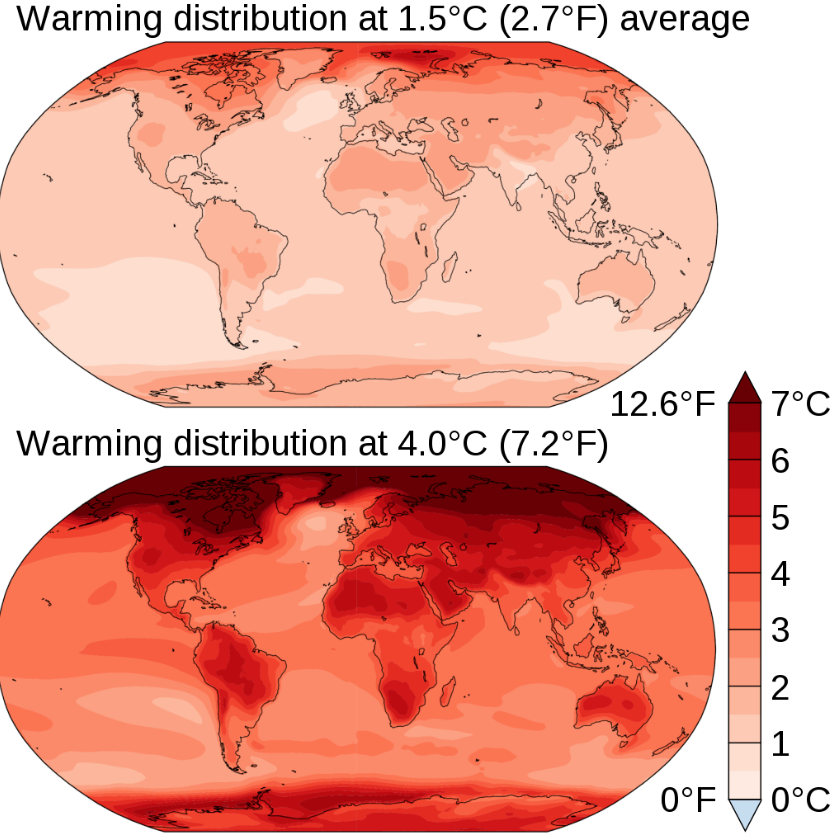
A climate model is a representation of the physical, chemical, and biological processes that affect the climate system.[87][101] Computer models attempt to reproduce and predict the circulation of the oceans, the annual cycle of the seasons, and the flows of carbon between the land surface and the atmosphere.[88][102] There are more than two dozen scientific institutions that develop climate models.[89][103] Models not only project different future temperature with different emissions of greenhouse gases, but also do not fully agree on the strength of different feedbacks on climate sensitivity and the amount of inertia of the system.[90][104]
Climate models incorporate different external forcings.[91][105] For different greenhouse gas inputs four RCPs (Representative Concentration Pathways) are used: "a stringent mitigation scenario (RCP2.6), two intermediate scenarios (RCP4.5 and RCP6.0) and one scenario with very high GHG [greenhouse gas] emissions (RCP8.5)".[92][106] Models also include changes in the Earth's orbit, historical changes in the Sun's activity, and volcanic forcing.[93][107] RCPs only look at concentrations of greenhouse gases, factoring out uncertainty as to whether the carbon cycle will continue to remove about half of the carbon dioxide from the atmosphere each year.[94][108] Climate model projections summarized in the report indicated that, during the 21st century, the global surface temperature is likely to rise a further 0.3 to 1.7 °C (0.5 to 3.1 °F) in a moderate scenario, or as much as 2.6 to 4.8 °C (4.7 to 8.6 °F) in an extreme scenario, depending on the rate of future greenhouse gas emissions and on climate feedback effects.[95][109]
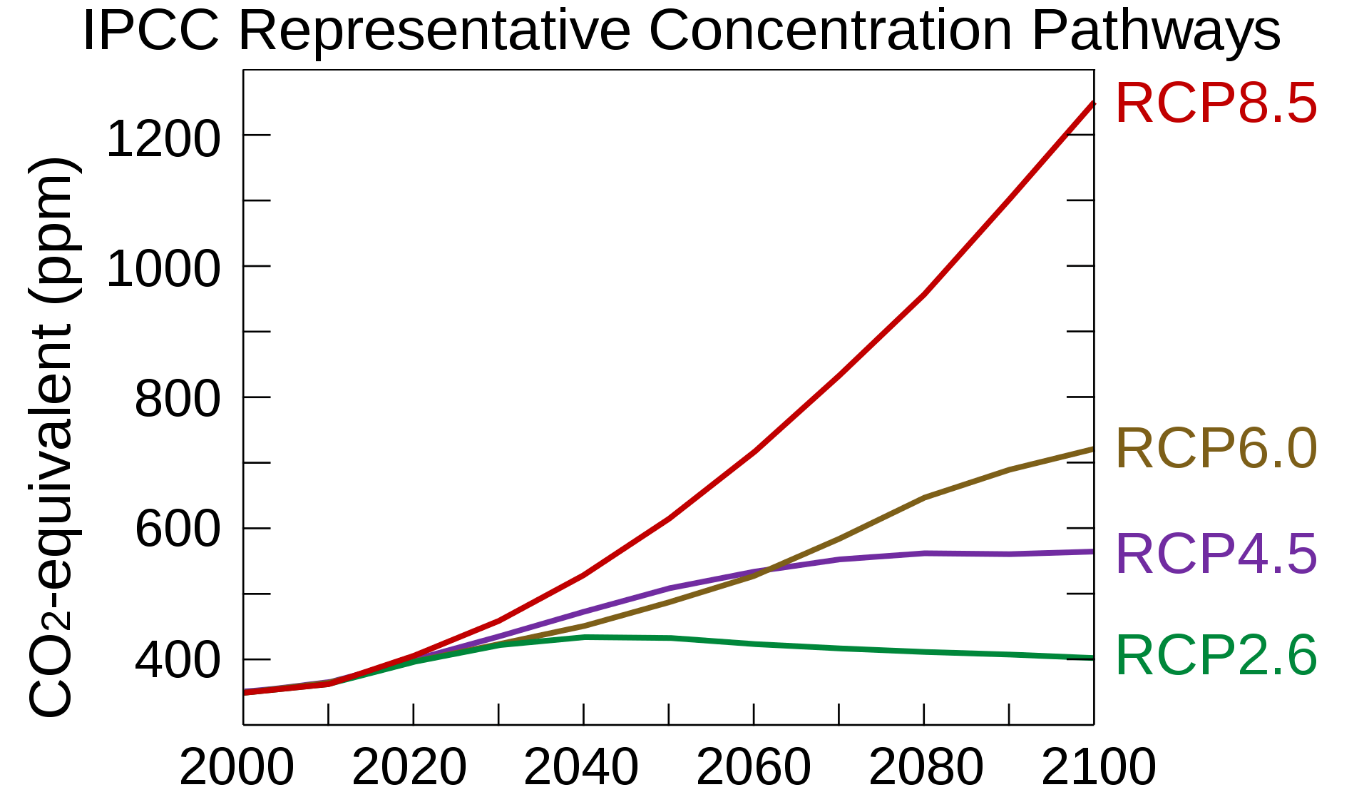
These models are also used to estimate the remaining carbon emissions budget. According to the IPCC, global warming can be kept below 1.5 °C with a two-thirds chance if emissions after 2018 do not exceed 420 or 570 GtCO
2 depending on the choice of the measure of global temperature. This amount corresponds to 10 to 13 years of current emissions. There are high uncertainties about the budget in either direction.[96][110]
The physical realism of models is tested by examining their ability to simulate contemporary or past climates.[97][111] Past models have underestimated the rate of Arctic shrinkage[98][112] and underestimated the rate of precipitation increase.[99][113] Sea level rise since 1990 was underestimated in older models, but now agrees well with observations.[100][114] The 2017 United States-published National Climate Assessment notes that "climate models may still be underestimating or missing relevant feedback processes".[101][115]
A subset of climate models add societal factors to a simple physical climate model. These models simulate how population, economic growth, and energy use affect – and interact with – the physical climate. With this information, these models can produce scenarios of how greenhouse gas emissions may vary in the future. This output is then used as input for physical climate models to generate climate change projections.[102][116] Emissions scenarios, estimates of changes in future emission levels of greenhouse gases, depend upon uncertain economic, sociological, technological, and natural developments.[103][117] In some scenarios emissions continue to rise over the century, while others have reduced emissions.[104][118] Fossil fuel reserves are abundant, and will not limit carbon emissions in the 21st century.[105][119]
Emission scenarios can be combined with modelling of the carbon cycle to predict how atmospheric concentrations of greenhouse gases might change in the future.[106][120] According to these combined models, by 2100 the atmospheric concentration of CO2 could be as low as 380 or as high as 1400 ppm, depending on the Shared Socioeconomic Pathway (SSP) the world takes and the mitigation scenario.[107][121] The 10th Emissions Gap Report issued by the United Nations Environment Programme (UNEP) predicts that if emissions continue to increase at the same rate as they have in 2010–2020, global temperatures would rise by as much as 4 °C by 2100.[108][122]
5. Effects
5.1. Physical Environment
The environmental effects of global warming are broad and far-reaching. They include effects on the oceans, ice, and weather and may occur gradually or rapidly. Evidence for these effects come from studying climate change in the past, modelling and modern observations.[110][124] Since the 1950s, droughts and heat waves have appeared simultaneously with increasing frequency.[111][125] Extremely wet or dry events within the monsoon period have increased in India and East Asia.[112][126] Various mechanisms have been identified that might explain extreme weather in mid-latitudes from the rapidly warming Arctic, such as the jet stream becoming more erratic.[113][127] The maximum rainfall and wind speed from hurricanes and typhoons is likely increasing.[114][128]
Between 1993 and 2017, the global mean sea level rose on average by 3.1 ± 0.3 mm per year, with an acceleration detected as well.[115][129] Over the 21st century, the IPCC projects that in a very high emissions scenario the sea level could rise by 61–110 cm.[116][130] The rate of ice loss from glaciers and ice sheets in the Antarctic is a key area of uncertainty since this source could account for 90% of the potential sea level rise:[117][131] increased ocean warmth is undermining and threatening to unplug Antarctic glacier outlets, potentially resulting in more rapid sea level rise.[118][132] The retreat of non-polar glaciers also contributes to sea level rise.[119][133]
Global warming has led to decades of shrinking and thinning of the Arctic sea ice, making it vulnerable to atmospheric anomalies.[120][134] Projections of declines in Arctic sea ice vary.[121][135] While ice-free summers are expected to be rare at 1.5 °C (2.7 °F) degrees of warming, they are set to occur once every three to ten years at a warming level of 2.0 °C (3.6 °F),[122][136] increasing the ice–albedo feedback.[123][137] Higher atmospheric CO
2 concentrations have led to an increase in dissolved CO2, which causes ocean acidification.[124][138] Furthermore, oxygen levels decrease because oxygen is less soluble in warmer water, an effect known as ocean deoxygenation.[125][139]
Long-term impacts and tipping points
The long-term effects of global warming include further ice melt, ocean warming, sea level rise, and ocean acidification. On the timescale of centuries to millennia, the magnitude of global warming will be determined primarily by anthropogenic CO2 emissions.[126][140] This is due to carbon dioxide's very long lifetime in the atmosphere.[126][140] Carbon dioxide is slowly taking up by the ocean, such that ocean acidification will continue for hundreds to thousands of years.[127][141] The emissions are estimated to have prolonged the current interglacial period by at least 100,000 years.[128][142] Because the great mass of glaciers and ice caps depressed the Earth's crust, another long-term effect of ice melt and deglaciation is the gradual rising of landmasses, a process called post-glacial rebound.[129][143] Sea level rise will continue over many centuries, with an estimated rise of 2.3 metres per degree Celsius (4.2 ft/°F) after 2000 years.[130][144]
If global warming exceeds 1.5 °C, there is a greater risk of passing through ‘tipping points’, thresholds beyond which certain impacts can no longer be avoided even if temperatures are reduced.[131][145] Some large-scale changes could occur abruptly, i.e. over a short time period. One potential source of abrupt tipping would be the rapid release of methane and carbon dioxide from permafrost, which would amplify global warming.[132][146] Another example is the possibility for the Atlantic Meridional Overturning Circulation to collapse,[133][147] which could trigger cooling in the North Atlantic, Europe, and North America.[134][148] If multiple temperature and carbon cycle tipping points re-inforce each other, or if there were to be strong threshold behaviour in cloud cover, there could be a global tipping into a hothouse Earth.[135][149]
5.2. Nature and Wildlife
In terrestrial ecosystems, the earlier arrival of spring, as well as poleward and upward shifts in plant and animal ranges, has been linked with high confidence to recent warming.[136][150] Higher atmospheric CO2 levels and an extended growing season have resulted in global greening, whereas heatwaves and drought have reduced ecosystem productivity in some regions. The future balance of these opposing effects is unclear.[137][151] Global warming has contributed to the expansion of drier climatic zones, such as, probably, the expansion of deserts in the subtropics.[138][152] Without substantial actions to reduce the rate of global warming, land-based ecosystems risk major shifts in their composition and structure.[139][153] Overall, it is expected that climate change will result in the extinction of many species and reduced diversity of ecosystems.[140][154]
The ocean has heated more slowly than the land, but plants and animals in the ocean have migrated towards the colder poles as fast as or faster than species on land.[141][155] Just as on land, heat waves in the ocean occur more due to climate change, with harmful effects found on a wide range of organisms such as corals, kelp, and seabirds.[142][156] Ocean acidification threatens damage to coral reefs, fisheries, protected species, and other natural resources of value to society.[143][157] Coastal ecosystems are under stress, with almost half of wetlands having disappeared as a consquence of climate change and other human impacts. Harmful algae blooms have increased due to warming, ocean deoxygenation and eutrophication.[144][158]
Climate change impacts on the environment.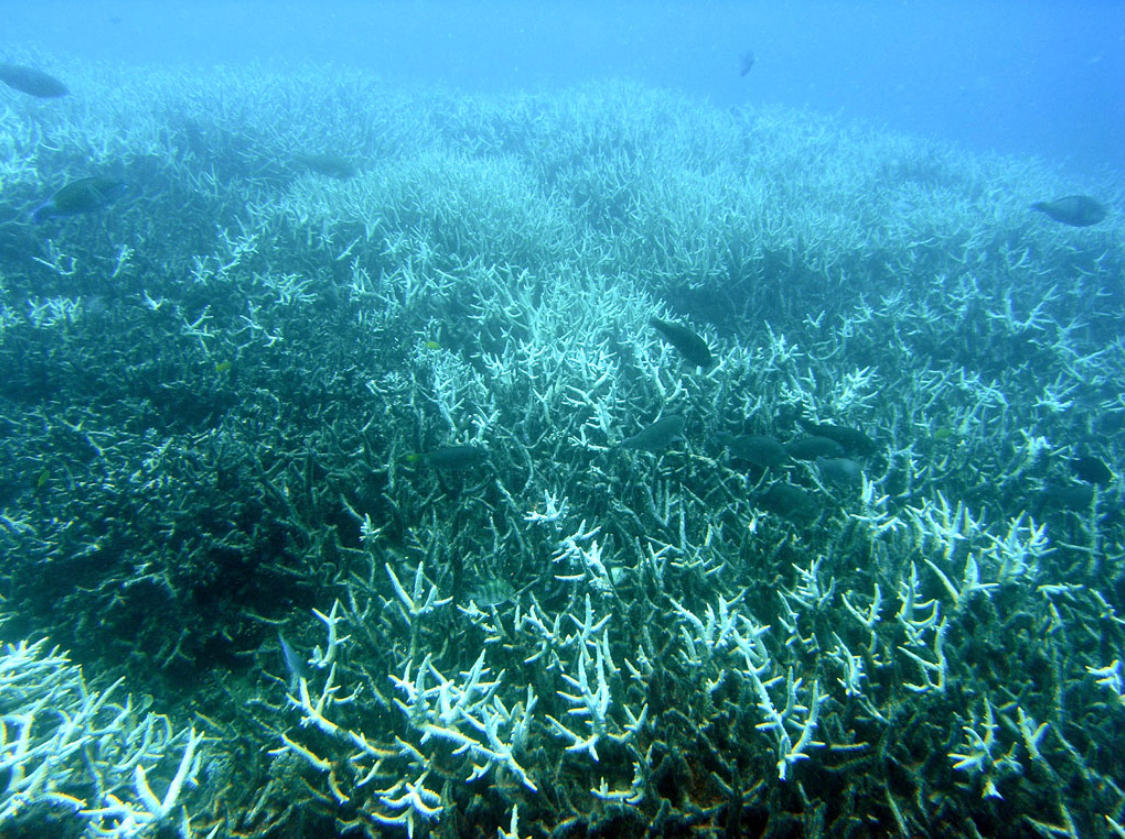

By Acropora at English Wikipedia, CC BY-SA 3.0, https://commons.wikimedia.org/w/index.php?curid=30432059
Ecological collapse possibilities. Bleaching has damaged the Great Barrier Reef and threatens reefs worldwide.[145][159]
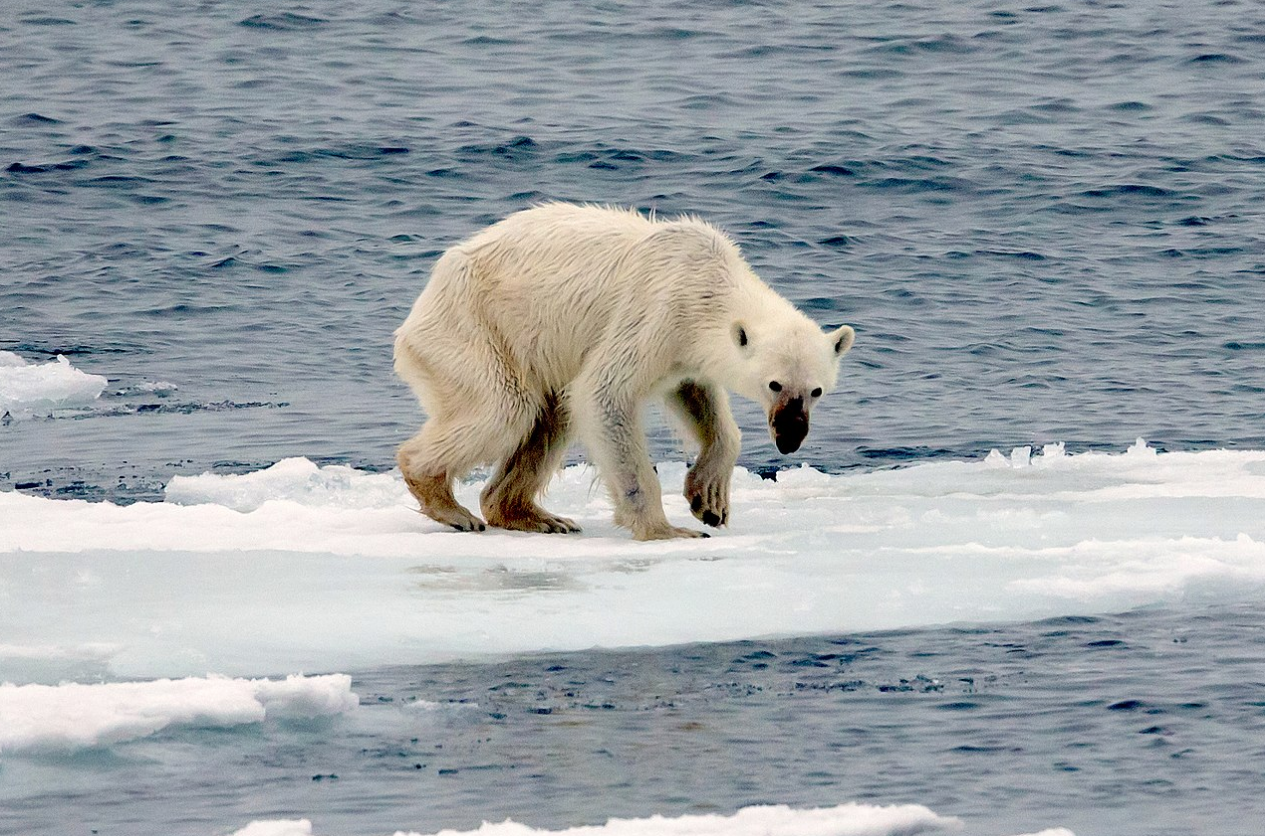
Habitat destruction. Many arctic animals rely on sea ice, which has been disappearing in a warming Arctic [147][161]. By Andreas Weith - File:Endangered_arctic_-_starving_polar_bear.jpg, CC BY-SA 4.0, https://commons.wikimedia.org/w/index.php?curid=89060415
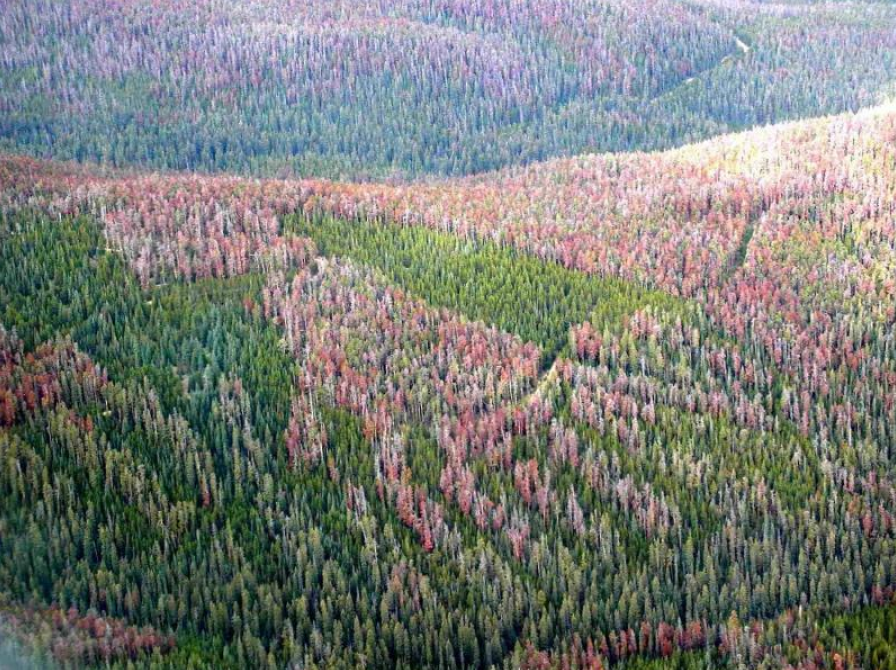
Pest propagation. Mild winters allow more pine beetles to survive to kill large swaths of forest [148][162].
5.3. Humans
The effects of climate change on human systems, mostly due to warming and shifts in precipitation, have been detected worldwide. The social impacts of climate change will be uneven across the world.[149][163] All regions are at risk of experiencing negative impacts,[150][164] with low-latitude, less developed areas facing the greatest risk.[151][165] Global warming has likely already increased global economic inequality, and is projected to do so in the future.[152][166] Regional impacts of climate change are now observable on all continents and across ocean regions.[153][167] The Arctic, Africa, small islands, and Asian megadeltas are regions that are likely to be especially affected by future climate change.[154][168] Many risks increase with higher magnitudes of global warming.[155][169]
Food and water
Crop production will probably be negatively affected in low-latitude countries, while effects at northern latitudes may be positive or negative.[156][170] Global warming of around 4 °C relative to late 20th century levels could pose a large risk to global and regional food security.[157][171] The impact of climate change on crop productivity for the four major crops was negative for wheat and maize, and neutral for soy and rice, in the years 1960–2013.[158][172] Up to an additional 183 million people worldwide, particularly those with lower incomes, are at risk of hunger as a consequence of warming.[159][173] While increased CO
2 levels help crop growth at lower temperature increases, those crops do become less nutritious.[159][173] Based on local and indigenous knowledge, climate change is already affecting food security in mountain regions in South America and Asia, and in various drylands, particularly in Africa.[159][173] Regions dependent on glacier water, regions that are already dry, and small islands are also at increased risk of water stress due to climate change.[160][174]
Livelihoods, industry, and infrastructure
In small islands and mega deltas, inundation from sea level rise is expected to threaten vital infrastructure and human settlements.[161][175] This could lead to homelessness in countries with low-lying areas such as Bangladesh, as well as statelessness for populations in island nations, such as the Maldives and Tuvalu.[162][176] Climate change can be an important driver of migration, both within and between countries.[163][177]
The majority of severe impacts of climate change are expected in sub-Saharan Africa and South-East Asia, where existing poverty is exacerbated.[164][178] Current inequalities between men and women, between rich and poor and between people of different ethnicity have been observed to worsen as a consequence of climate variability and climate change.[165][179] Existing stresses include poverty, political conflicts, and ecosystem degradation. Regions may even become uninhabitable, with humidity and temperatures reaching levels too high for humans to survive.[166][180] In June 2019, U.N. special rapporteur Philip Alston indicated that global warming could "push more than 120 million more people into poverty by 2030 and will have the most severe impact in poor countries, regions, and the places poor people live and work".[167][181]
Health and security
Generally, impacts on public health will be more negative than positive.[168][182] Impacts include the direct effects of extreme weather, leading to injury and loss of life;[169][183] and indirect effects, such as undernutrition brought on by crop failures.[170][184] Various infectious diseases are more easily transmitted in a warming climate, such as dengue fever, which affects children most severely, and malaria.[171][185] Young children are further the most vulnerable to food shortages, and together with older people to extreme heat.[172][186] Temperature rise has been connected to increased numbers of suicides.[173][187] Climate change has been linked to an increase in violent conflict by amplifying poverty and economic shocks, which are well-documented drivers of these conflicts.[174][188] Links have been made between a wide range of violent behaviour including, violent crimes, civil unrest, and wars, but conclusive scientific evidence remains elusive.[175][189]
- Climate change impacts on people
-
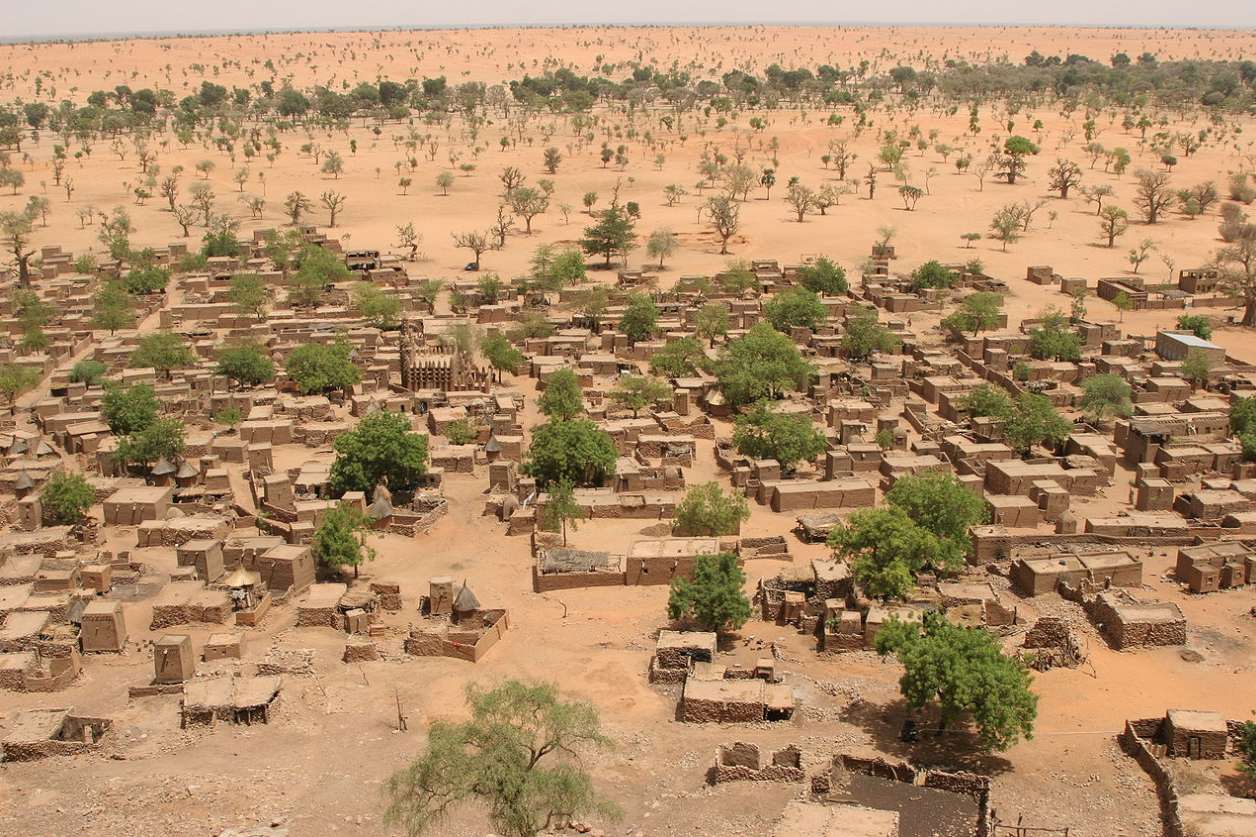
-
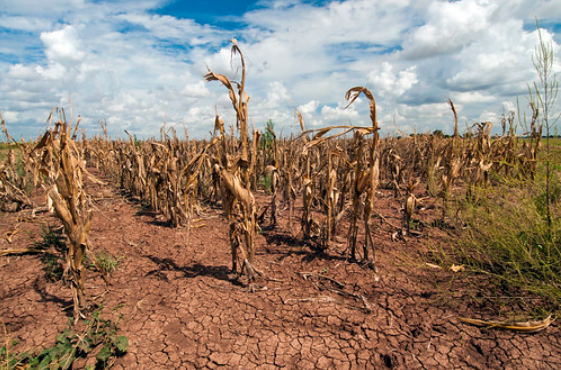
Farming. Droughts, rising temperatures, and extreme weather negatively impact agriculture [177][191]. By USDA photo by Bob Nichols - https://www.usda.gov/media/blog/2014/02/11/southern-plains-climate-hub-seeks-address-three-huge-problems, Public Domain, https://commons.wikimedia.org/w/index.php?curid=89060994
-
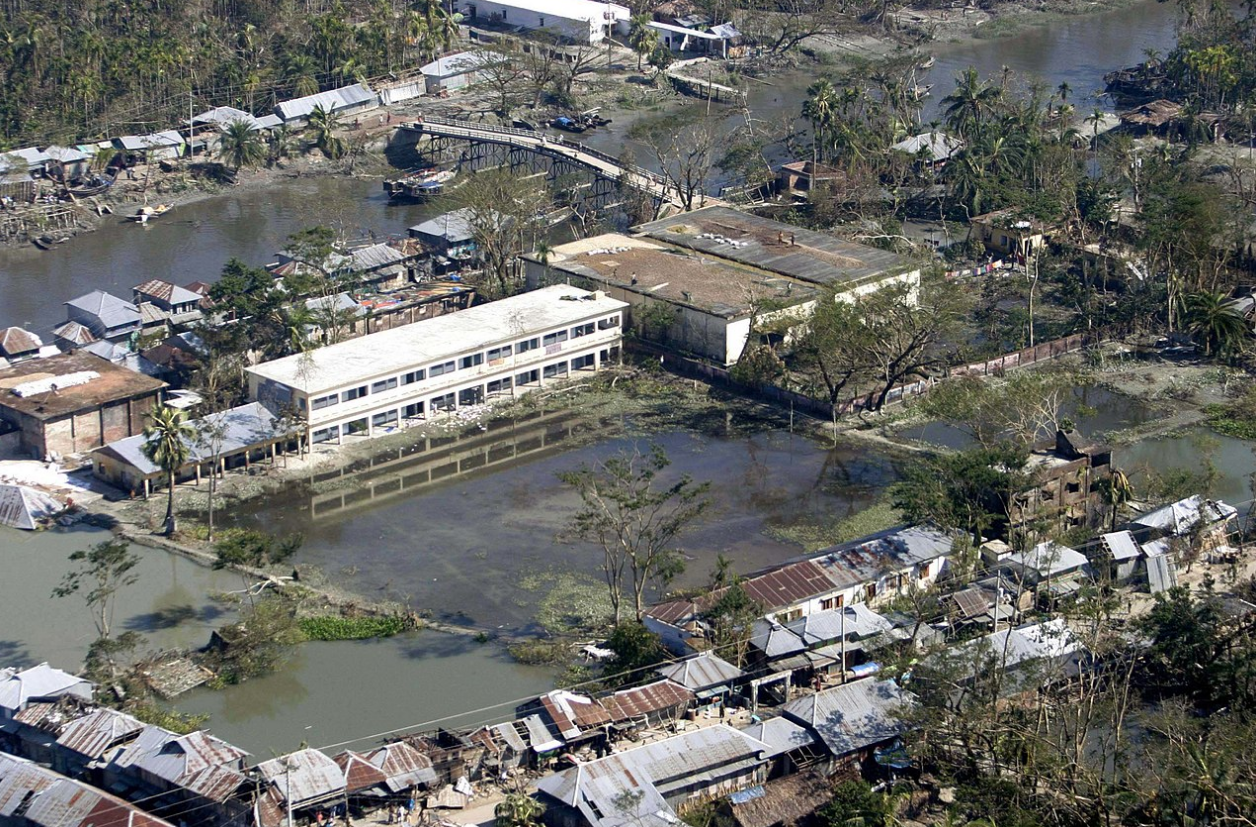
-
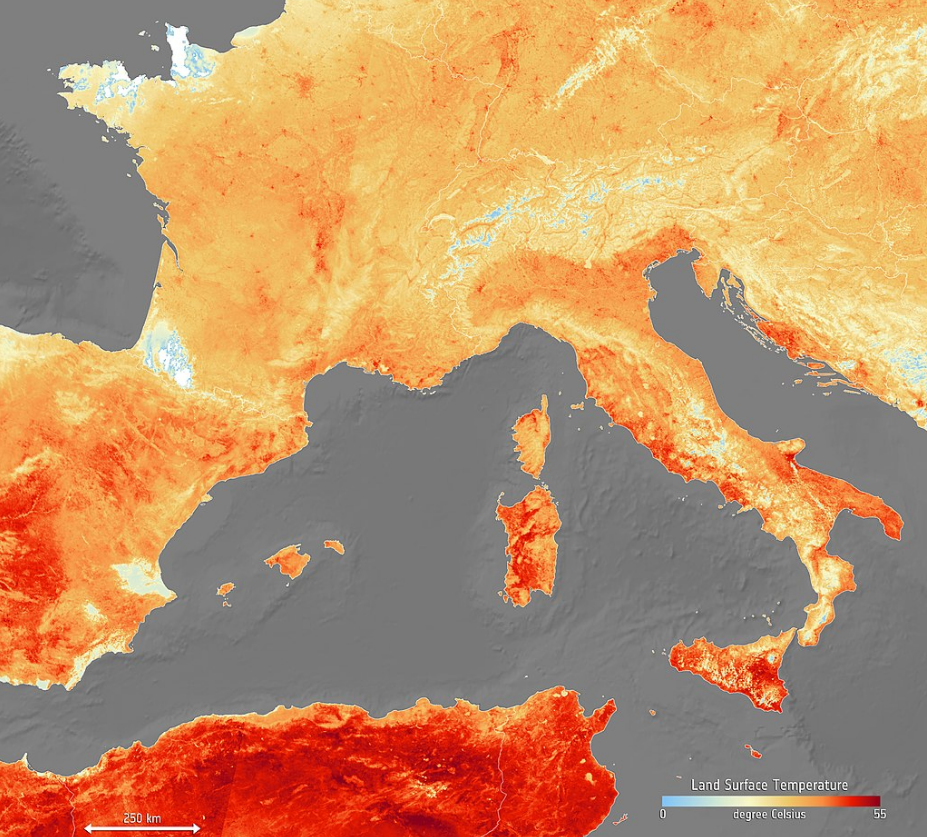
6. Responses
Mitigation of and adaptation to climate change are two complementary responses to global warming. Successful adaptation is easier if there are substantial emission reductions. Many of the countries that have contributed least to global greenhouse gas emissions are among the most vulnerable to climate change, which raises questions about justice and fairness with regard to mitigation and adaptation.[181][196]
6.1. Mitigation
Climate change impacts can be mitigated by reducing greenhouse gas emissions and by enhancing the capacity of Earth's land surface to absorb greenhouse gases from the atmosphere.[182][197] In order to limit global warming to less than 1.5°C with a high likelihood of success, the IPCC estimates that global GHG emissions will need to be net zero by 2050,[183][198] or by 2070 with a 2°C target. This will require far-reaching, systemIc changes on an unprecedented scale in energy, land, cities, transport, buildings, and industry.[184][199] To make progress towards that goal, the United Nations Environment Programme estimates that, within the next decade, countries will need to triple the amount of reductions they have committed to in their current Paris agreements.[185][200]
Technologies and other methods
Long-term scenarios all point to rapid and significant investment in renewable energy and energy efficiency as key to reducing GHG emissions.[186][201] These technologies include solar and wind power, bioenergy, geothermal energy, and hydroelectricity. Combined, they are capable of supplying several times the world’s current energy needs.[187][202] Solar PV and wind, in particular, have seen substantial growth and progress over the last few years,[188][203] such that they are currently among the cheapest sources of new power generation.[189][204] Renewables represented 75% of all new electricity generation installed in 2019, with solar and wind constituting nearly all of that amount.[190][205] However, fossil fuels continue to dominate world energy supplies. In 2018 fossil fuels produced 80% of the world’s energy, with modern renewable sources, including solar and wind power, accounting for around 11%.[191][206]
There are obstacles to the rapid development of renewable energy. Environmental and land use concerns are sometimes associated with large solar, wind and hydropower projects.[192][207] Solar and wind power also require energy storage systems and other modifications to the electricity grid to operate effectively,[193][208] although several storage technologies are now emerging to supplement the traditional use of pumped-storage hydropower.[194][209] The use of rare metals and other hazardous materials has also been raised as a concern with solar power.[195][210] The use of bioenergy is often not carbon neutral, and may have negative consequences for food security,[196][211] largely due to the amount of land required compared to other renewable energy options.[197][212]
For certain energy supply needs, as well as specific CO
2-intensive heavy industries, carbon capture and storage may be a viable method of reducing CO
2 emissions. Although high costs have been a concern with this technology,[198][213] it may be able to play a significant role in limiting atmospheric CO
2 concentrations by mid-century.[199][214]
Greenhouse gas emissions can be offset by enhancing Earth’s land carbon sink to sequester significantly larger amounts of CO
2 beyond naturally occurring levels.[200][215] Forest preservation, reforestation and tree planting on non-forest lands are considered the most effective, although they may present food security concerns. Soil management on croplands and grasslands is another effective mitigation technique. For all these approaches there remain large scientific uncertainties with implementing them on a global scale.[201][216]
Individuals can also take actions to reduce their carbon footprint. These include: driving an EV or other energy efficient car and reducing vehicles miles by using mass transit or cycling; adopting a plant-based diet; reducing energy use in the home; limiting consumption of goods and services; and foregoing air travel.[202][217]
Scenarios and strategies for 2050
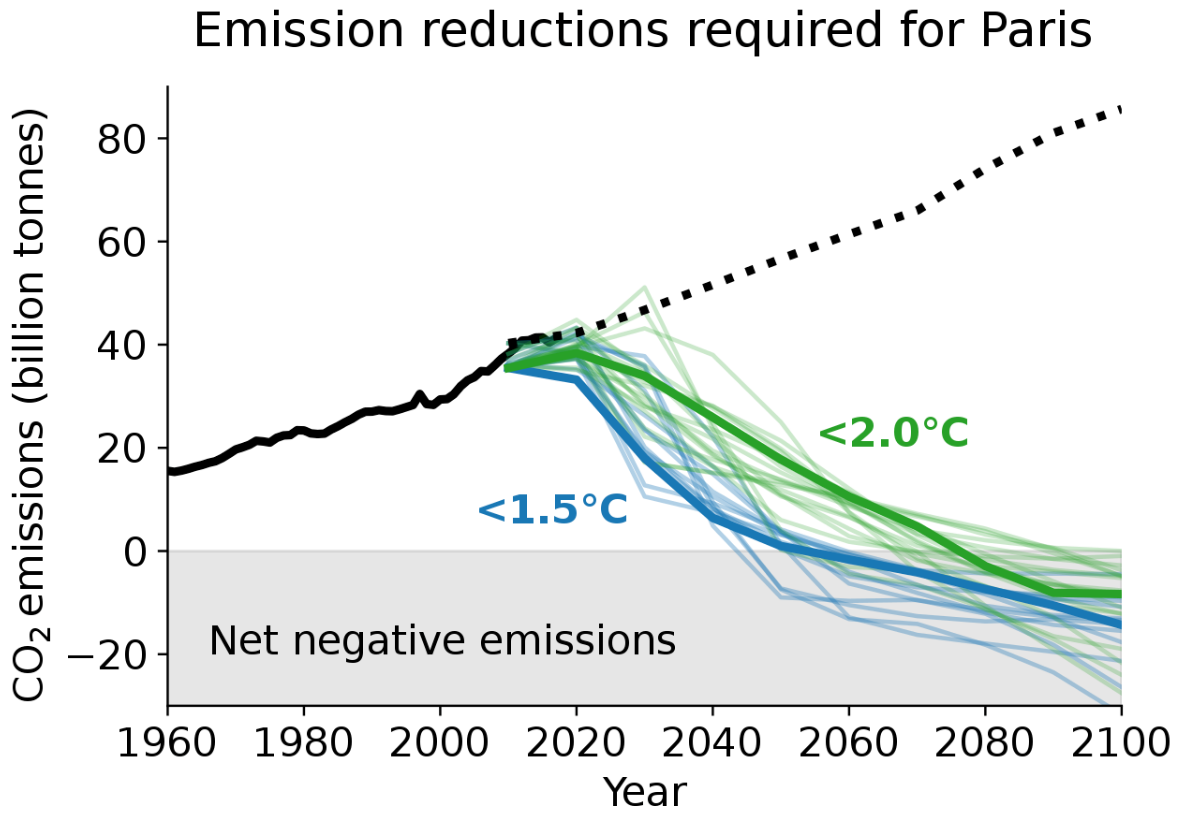
Although there is no single pathway to limit global warming to 1.5 or 2°C,[203][218] most scenarios and strategies see a major increase in the use of renewable energy in combination with increased energy efficiency measures to generate the needed greenhouse gas reductions.[204][219] Forestry and agriculture components also include steps to reduce pressures on ecosystems and enhance their carbon sequestration capabilities.[205][220] Scenarios that limit global warming to 1.5°C generally project the large scale use of carbon dioxide removal methods to augment the greenhouse gas reduction approaches mentioned above.[206][221]
Renewable energy would become the dominant form of electricity generation, rising to 85% or more by 2050 in some scenarios. The use of electricity for other needs, such as heating, would rise to the point where electricity becomes the largest form of overall energy supply by 2050.[207][222] Investment in coal would be eliminated and coal use nearly phased out by 2050.[208][223]
In transport, scenarios envision sharp increases in the market share of electric vehicles, low carbon fuel substitution for other transportation modes like shipping, and changes in transportation patterns to reduce overall demand, for example increased public transport.[209][224] Buildings will see additional electrification with the use of technologies like heat pumps, as well as continued energy efficiency improvements achieved via low energy building codes.[210][225] Industrial efforts will focus on increasing the energy efficiency of production processes, such as the use of cleaner technology for cement production,[211][226] designing and creating less energy intensive products, increasing product lifetimes, and developing incentives to reduce product demand.[212][227]
The agriculture and forestry sector faces a triple challenge of limiting greenhouse gas emissions, preventing further conversion of forests to agricultural land, and meeting increases in world food demand.[213][228] A suite of actions could reduce agriculture/forestry based greenhouse gas emissions by 66% from 2010 levels by reducing growth in demand for food and other agricultural products, increasing land productivity, protecting and restoring forests, and reducing GHG emissions from agricultural production.[214][229]
Policies and measures
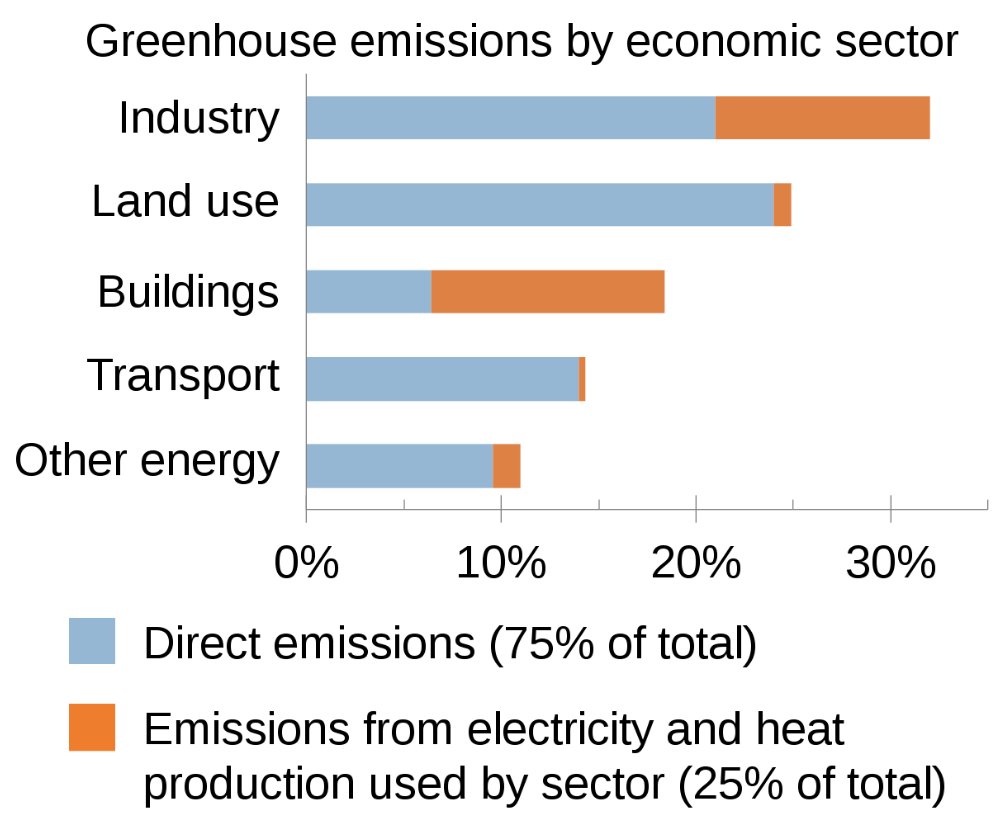
A wide range of policies, regulations and laws are being used to reduce greenhouse gases. Carbon pricing mechanisms include carbon taxes and emissions trading systems.[215][230] As of 2019, carbon pricing covers about 20% of global greenhouse gas emissions.[216][231] Renewable portfolio standards have been enacted in several countries to move utilities to increase the percentage of electricity they generate from renewable sources.[217][232] Phasing out of fossil fuel subsidies, currently estimated at $300 billion globally (about twice the level of renewable energy subsidies),[218][233] could reduce greenhouse gas emissions by 6%.[219][234] Subsidies could also be redirected to support the transition to clean energy.[220][235] More prescriptive methods that can reduce greenhouse gases include vehicle efficiency standards,[221][236] renewable fuel standards, and air pollution regulations on heavy industry.[222][237]
As the use of fossil fuels is reduced, there are Just Transition considerations involving the social and economic challenges that arise. An example is the employment of workers in the affected industries, along with the well-being of the broader communities involved.[223][238] Climate justice considerations, such as those facing indigenous populations in the Arctic,[224][239] are another important aspect of mitigation policies.[225][240]
6.2. Adaptation
Adaptation is “the process of adjustment to current or expected changes in climate and its effects”. As climate change varies across regions, adaptation does too.[226][241] While some adaptation responses call for trade-offs, others bring synergies and co-benefits.[227][242] Examples of adaptation are improved coastline protection, better disaster management, and the development of more resistant crops.[228][243] Increased use of air conditioning allows people to better cope with heat, but also increases energy demand.[229][244] Adaptation is especially important in developing countries since they are predicted to bear the brunt of the effects of global warming.[230][245] The capacity and potential for humans to adapt, called adaptive capacity, is unevenly distributed across different regions and populations, and developing countries generally have less capacity to adapt.[231][246] The public sector, private sector, and communities are all gaining experience with adaptation, and adaptation is becoming embedded within certain planning processes.[232][247] There are limits to adaptation and more severe climate change requires more transformative adaptation, which can be prohibitatively expensive.[226][241]
6.3. Climate Engineering
Geoengineering or climate engineering is the deliberate large-scale modification of the climate to counteract climate change.[233][248] Techniques fall generally into the categories of solar radiation management and carbon dioxide removal, although various other schemes have been suggested. A study from 2014 investigated the most common climate engineering methods and concluded that they are either ineffective or have potentially severe side effects and cannot be stopped without causing rapid climate change.[234][249]
7. Society and Culture
7.1. Political Response
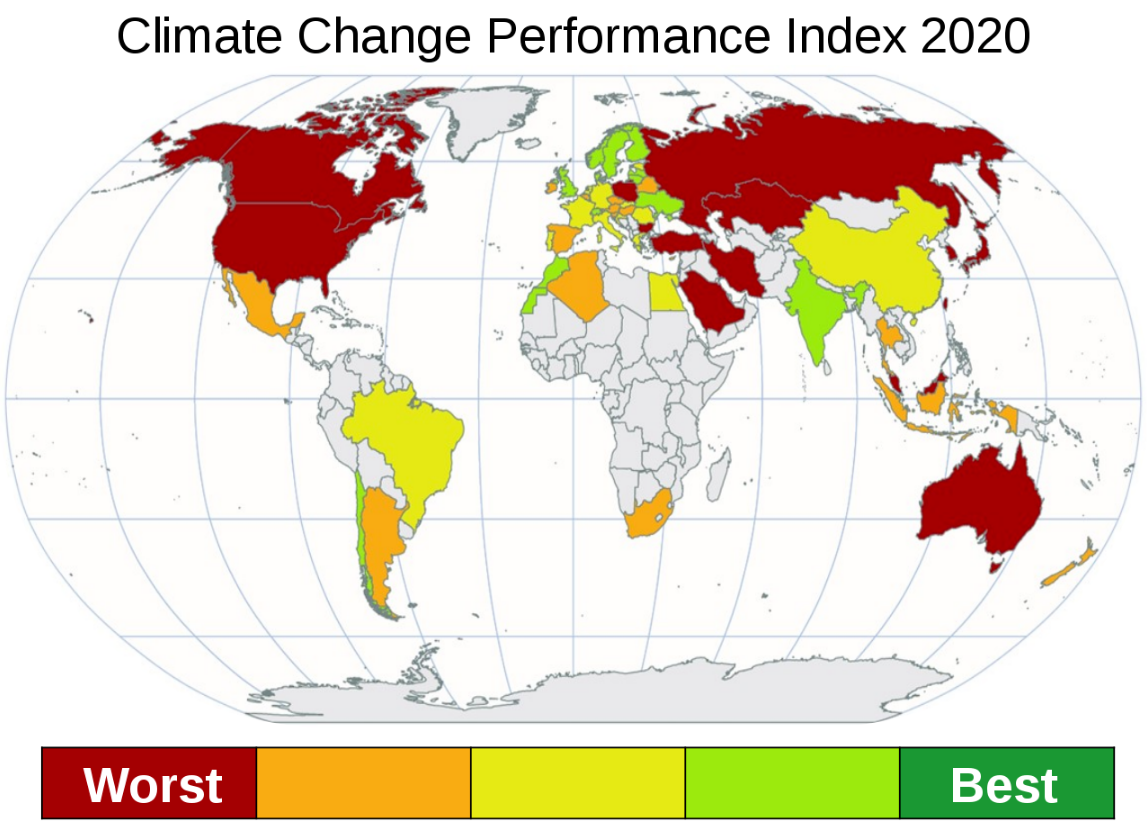
UN Framework Convention
(As of 2020) nearly all countries in the world are parties to the United Nations Framework Convention on Climate Change (UNFCCC).[235][250] The objective of the Convention is to prevent dangerous human interference with the climate system.[236][251] As stated in the Convention, this requires that greenhouse gas concentrations are stabilized in the atmosphere at a level where ecosystems can adapt naturally to climate change, food production is not threatened, and economic development can be sustained.[237][252] The Framework Convention was agreed on in 1992, but global emissions have risen since then.[45][59] Its yearly conferences are the stage of global negotiations.[238][253]
This mandate was sustained in the 1997 Kyoto Protocol to the Framework Convention.[239][254] In ratifying the Kyoto Protocol, most developed countries accepted legally binding commitments to limit their emissions. These first-round commitments expired in 2012.[240][255] United States President George W. Bush rejected the treaty on the basis that "it exempts 80% of the world, including major population centres such as China and India, from compliance, and would cause serious harm to the US economy".[241][256] During these negotiations, the G77 (a lobbying group in the United Nations representing developing countries)[242][257] pushed for a mandate requiring developed countries to "[take] the lead" in reducing their emissions.[243][258] This was justified on the basis that the developed countries' emissions had contributed most to the accumulation of greenhouse gases in the atmosphere, per-capita emissions were still relatively low in developing countries, and the emissions of developing countries would grow to meet their development needs.[244][259]
In 2009 several UNFCCC Parties produced the Copenhagen Accord,[246][261] which has been widely portrayed as disappointing because of its low goals, leading poorer nations to reject it.[247][262] Nations associated with the Accord aimed to limit the future increase in global mean temperature to below 2 °C.[248][263] In 2015 all UN countries negotiated the Paris Agreement, which aims to keep climate change well below 2 °C. The agreement replaced the Kyoto Protocol. Unlike Kyoto, no binding emission targets are set in the Paris Agreement. Instead, the procedure of regularly setting ever more ambitious goals and reevaluating these goals every five years has been made binding.[249][264] The Paris Agreement reiterated that developing countries must be financially supported.[250][265] (As of November 2019), 194 states and the European Union have signed the treaty and 186 states and the EU have ratified or acceded to the agreement.[251][266] In November 2019 the Trump administration notified the UN that it would withdraw the United States from the Paris Agreement in 2020.[252][267]
Other policy
In 2019, the British Parliament became the first national government in the world to officially declare a climate emergency.[253][268] Other countries and jurisdictions followed.[254][269] In November 2019 the European Parliament declared a "climate and environmental emergency",[255][270] and the European Commission presented its European Green Deal with which they hope to make the EU carbon-neutral in 2050.[256][271]
While the ozone layer and climate change are considered separate problems, the solution to the former has significantly mitigated global warming. The estimated mitigation of the Montreal Protocol, an international agreement to stop emitting ozone-depleting gases, is estimated to have been more effective than the Kyoto Protocol, which was specifically designed to curb greenhouse gas emissions.[257][272] It has been argued that the Montreal Protocol may have done more than any other measure, (As of 2017), to mitigate climate change as those substances were also powerful greenhouse gases.[258][273]
7.2. Scientific Consensus
In the scientific literature, there is an overwhelming consensus that global surface temperatures have increased in recent decades and that the trend is caused mainly by human-induced emissions of greenhouse gases.[260][275] No scientific body of national or international standing disagrees with this view.[261][276] Scientific discussion takes place in journal articles that are peer-reviewed, which scientists subject to assessment every couple of years in the Intergovernmental Panel on Climate Change reports.[262][277] In 2013, the IPCC Fifth Assessment Report stated that "is extremely likely that human influence has been the dominant cause of the observed warming since the mid-20th century".[263][278] Their 2018 report expressed the scientific consensus as: "human influence on climate has been the dominant cause of observed warming since the mid-20th century".[264][279]
Consensus has further developed that some form of action should be taken to protect people against the impacts of climate change, and national science academies have called on world leaders to cut global emissions.[265][280] In 2017, in the second warning to humanity, 15,364 scientists from 184 countries stated that "the current trajectory of potentially catastrophic climate change due to rising greenhouse gases from burning fossil fuels, deforestation, and agricultural production – particularly from farming ruminants for meat consumption" is "especially troubling".[266][281] In 2019, a group of more than 11,000 scientists from 153 countries named climate change an "emergency" that would lead to "untold human suffering" if no big shifts in action takes place.[267][282] The emergency declaration emphasized that economic growth and population growth "are among the most important drivers of increases in CO
2 emissions from fossil fuel combustion" and that "we need bold and drastic transformations regarding economic and population policies".[268][283]
7.3. Public Debate
The global warming problem came to international public attention in the late 1980s.[269][284] Due to confusing media coverage in the early 1990s, issues such as ozone depletion and climate change were often mixed up, affecting public understanding of these issues.[270][285] Although there are a few areas of linkage, the relationship between the two is weak.[271][286]
Significant regional differences exist in how concerned people are about climate change and how much they understand the issue.[272][287] In 2010, just a little over half the US population viewed it as a serious concern for either themselves or their families, while 73% of people in Latin America and 74% in developed Asia felt this way.[273][288] Similarly, in 2015 a median of 54% of respondents considered it "a very serious problem", but Americans and Chinese (whose economies are responsible for the greatest annual CO2 emissions) were among the least concerned.[272][287] Worldwide in 2011, people were more likely to attribute global warming to human activities than to natural causes, except in the US where nearly half of the population attributed global warming to natural causes.[274][289] Public reactions to global warming and concern about its effects have been increasing, with many perceiving it as the worst global threat.[275][290] In a 2019 CBS poll, 64% of the US population said that climate change is a "crisis" or a "serious problem", with 44% saying human activity was a significant contributor.[276][291]
Denial and misinformation
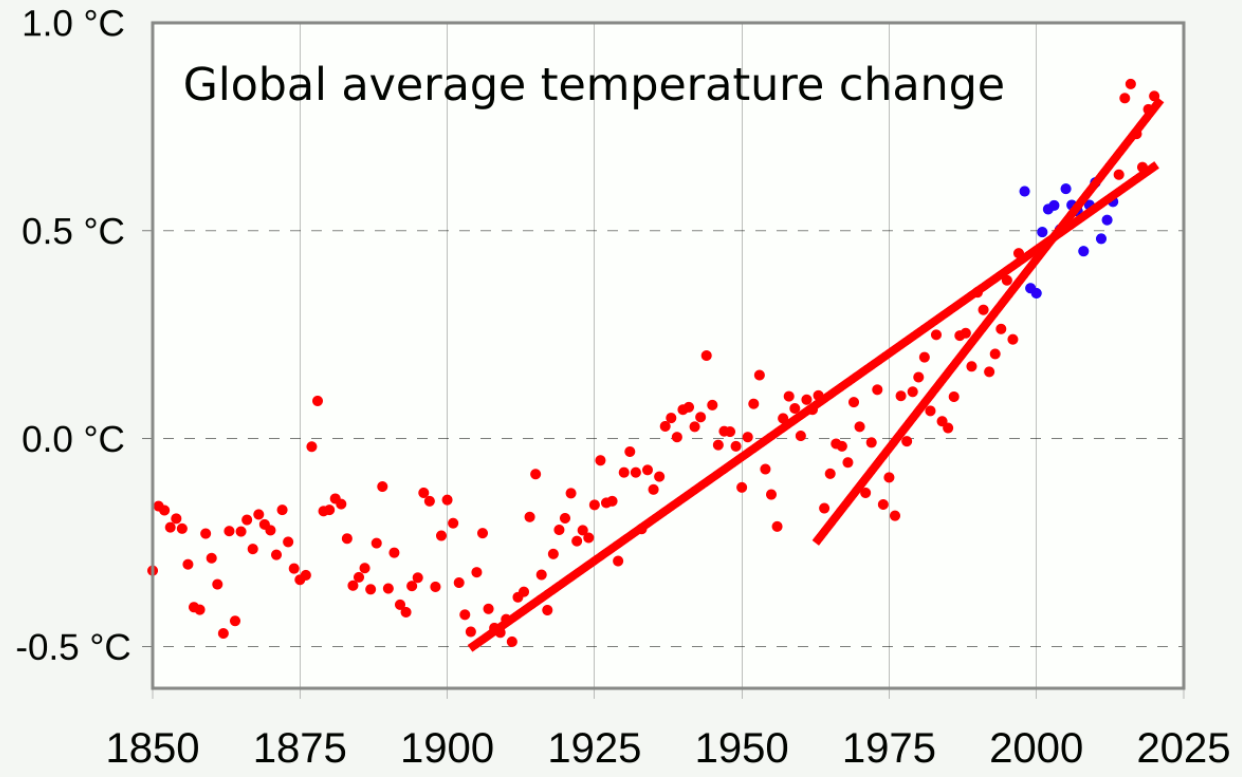
Public debate about climate change has been strongly affected by climate change denial and misinformation, which originated in the United States and has since spread to other countries, particularly Canada and Australia. The actors behind climate change denial form a well-funded and relatively coordinated coalition of fossil fuel companies, industry groups, conservative think tanks, and contrarian scientists.[278][293] Like the tobacco industry before, the main strategy of these groups has been to manufacture doubt about scientific data and results.[279][294] Many who deny, dismiss, or hold unwarranted doubt about the scientific consensus on anthropogenic global warming are labelled as "climate change skeptics", which several scientists have noted is a misnomer.[280][295]
There are different variants of climate denial: some deny that warming takes place at all, some acknowledge warming but attribute it to natural influences, and some minimize the negative impacts of climate change.[281][296] Manufacturing uncertainty about the science later developed into a manufacturing of controversy: creating the belief that there remains significant uncertainty about climate change within the scientific community in order to delay policy changes.[282][297] Strategies to promote these ideas include a criticism of scientific institutions,[283][298] and questioning the motives of individual scientists.[284][299] An "echo chamber" of climate-denying blogs and media has further fomented misunderstanding of global warming.[285][300]
Protest and litigation
Protests seeking more ambitious climate action increased in the 2010s in the form of fossil fuel divestment,[286][301] and worldwide demonstrations.[287][302] In particular, youth across the globe protested by skipping school, inspired by Swedish teenager Greta Thunberg in the school strike for climate.[288][303] Mass civil disobedience actions by Extinction Rebellion and Ende Gelände have ended in police intervention and large-scale arrests.[289][304] Litigation is increasingly used as a tool to strengthen climate action, with governments being the biggest target of lawsuits demanding that they become ambitious on climate action or enforce existing laws. Cases against fossil-fuel companies, from activists, shareholders and investors, generally seek compensation for loss and damage.[290][305]
8. Discovery
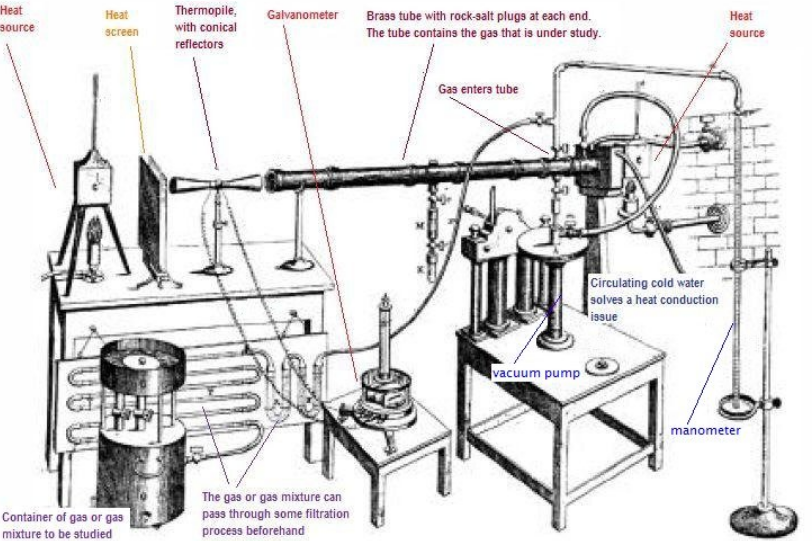
In 1681 Mariotte noted that glass, though transparent to sunlight, obstructs radiant heat.[291][306] Around 1774 de Saussure showed that non-luminous warm objects emit infrared heat, and used a glass-topped insulated box to trap and measure heat from sunlight.[292][307] In 1824 Joseph Fourier proposed by analogy a version of the greenhouse effect; transparent atmosphere lets through visible light, which warms the surface. The warmed surface emits infrared radiation, but the atmosphere is relatively opaque to infrared and slows the emission of energy, warming the planet.[293][308] Starting in 1859,[294][309] John Tyndall established that nitrogen and oxygen (99% of dry air) are transparent to infrared, but water vapour and traces of some gases (significantly methane and carbon dioxide) both absorb infrared and, when warmed, emit infrared radiation. Changing concentrations of these gases could have caused "all the mutations of climate which the researches of geologists reveal" including ice ages.[295][310]
Svante Arrhenius noted that water vapour in air continuously varied, but carbon dioxide (CO
2) was determined by long term geological processes. At the end of an ice age, warming from increased CO
2 would increase the amount of water vapour, amplifying its effect in a feedback process. In 1896, he published the first climate model of its kind, showing that halving of CO
2 could have produced the drop in temperature initiating the ice age. Arrhenius calculated the temperature increase expected from doubling CO
2 to be around 5–6 °C (9.0–10.8 °F).[296][311] Other scientists were initially sceptical and believed the greenhouse effect to be saturated so that adding more CO
2 would make no difference. Experts thought climate would be self-regulating.[297][312] From 1938 Guy Stewart Callendar published evidence that climate was warming and CO
2 levels increasing,[298][313] but his calculations met the same objections.[297][312]
Early calculations treated the atmosphere as a single layer: Gilbert Plass used digital computers to model the different layers and found added CO
2 would cause warming. Hans Suess found evidence CO
2 levels had been rising, Roger Revelle showed the oceans would not absorb the increase, and together they helped Charles Keeling to begin a record of continued increase, the Keeling Curve.[297][312] Scientists alerted the public,[299][314] and the dangers were highlighted at James Hansen's 1988 Congressional testimony.[300][315] The Intergovernmental Panel on Climate Change, set up in 1988 to provide formal advice to the world's governments, spurred interdisciplanary research.[301][316]
9. Terminology
Research in the 1950s suggested that temperatures were increasing, and a 1952 newspaper used the term "climate change". This phrase next appeared in a November 1957 report in The Hammond Times which described Roger Revelle's research into the effects of increasing human-caused CO
2 emissions on the greenhouse effect: "a large scale global warming, with radical climate changes may result". A 1971 MIT report referred to the human impact as "inadvertent climate modification", identifying many possible causes. Both the terms global warming and climate change were used only occasionally until 1975, when Wallace Smith Broecker published a scientific paper on the topic, "Climatic Change: Are We on the Brink of a Pronounced Global Warming?". The phrase began to come into common use, and in 1976 Mikhail Budyko's statement that "a global warming up has started" was widely reported.[299][314] An influential 1979 National Academy of Sciences study headed by Jule Charney followed Broecker in using global warming to refer to rising surface temperatures, while describing the wider effects of increased CO
2 as climate change.[302][317]
There were increasing heatwaves and drought problems in the summer of 1988, and NASA climate scientist James Hansen's testimony in the U.S. Senate sparked worldwide interest.[300][315] He said, "Global warming has reached a level such that we can ascribe with a high degree of confidence a cause and effect relationship between the greenhouse effect and the observed warming."[303][318] Public attention increased over the summer, and global warming became the dominant popular term, commonly used both by the press and in public discourse.[302][317] In the 2000s, the term climate change increased in popularity.[304][319] The term climate change is also used to refer to past and future climate changes that persist for an extended period of time, and includes regional changes as well as global change.[305][320] The two terms are often used interchangeably.[306][321]
Various scientists, politicians and news media have adopted the terms climate crisis or a climate emergency to talk about climate change, while using global heating instead of global warming.[307][322] The policy editor-in-chief of The Guardian explained why they included this language in their editorial guidelines: "We want to ensure that we are being scientifically precise, while also communicating clearly with readers on this very important issue".[308][323] Oxford Dictionary chose climate emergency as the word of the year 2019 and defines the term as "a situation in which urgent action is required to reduce or halt climate change and avoid potentially irreversible environmental damage resulting from it".[309][324]

